Nepal
Nepal (English: /nɪˈpɔːl/;[17] Nepali: नेपाल [neˈpal]), officially the Federal Democratic Republic of Nepal,[18] is a country in South Asia. It is mainly in the Himalayas, but also includes parts of the Indo-Gangetic Plain. It is the 49th largest country by population and 93rd largest country by area. It is landlocked, and borders China in the north and India in the south, east and west, while Bangladesh is located within only 27 km (17 mi) of its southeastern tip and Bhutan is separated from it by the Indian state of Sikkim. Nepal has a diverse geography, including fertile plains, subalpine forested hills, and eight of the world's ten tallest mountains, including Mount Everest, the highest point on Earth. Kathmandu is the capital and the largest city. Nepal is a multiethnic country with Nepali as the official language.
Federal Democratic Republic of Nepal
| |
|---|---|
Motto: "Janani Janmabhumishcha Swargadapi Gariyasi" (Sanskrit) "Mother and motherland are greater than heaven" | |
.svg.png) Area controlled by Nepal shown in dark green; regions claimed but not controlled shown in light green | |
| Capital | Kathmandu[1] 28°10′N 84°15′E |
| Largest city | Kathmandu[1] |
| Official languages | Nepali[2] |
| Recognised national languages | All mother-tongues[3][4] (see Languages of Nepal) |
| Ethnic groups | |
| Religion | |
| Demonym(s) | Nepali, Nepalese |
| Government | Federal parliamentary republic |
| Bidhya Devi Bhandari[6] | |
| Khadga Prasad Sharma Oli[6] | |
| Agni Prasad Sapkota[7] | |
| Cholendra Shumsher JB Rana[8] | |
| Legislature | Federal Parliament |
| National Assembly | |
| House of Representatives | |
| Formation | |
• Kingdom | 1768[9] |
| 28 May 2008 | |
| 20 September 2015 | |
| Area | |
• Total | 147,516 km2 (56,956 sq mi) (93rd) |
• Water (%) | 2.8 |
| Population | |
• 2018 estimate | |
• 2011 census | 26,494,504[12] |
• Density | 180/km2 (466.2/sq mi) (50th) |
| GDP (PPP) | 2019 estimate |
• Total | |
• Per capita | |
| GDP (nominal) | 2019 estimate |
• Total | |
• Per capita | |
| Gini (2010) | 32.8[14] medium · 115th |
| HDI (2019) | medium · 147th |
| Currency | Nepalese rupee (Rs, रू) (NPR) |
| Time zone | UTC+05:45 (Nepal Standard Time) |
| DST not observed | |
| Mains electricity | 230 V–50 Hz[16] |
| Driving side | left |
| Calling code | +977 |
| ISO 3166 code | NP |
| Internet TLD | .np |
The name "Nepal" is first recorded in texts from the Vedic period of the Indian subcontinent, the era in ancient India when Hinduism was founded, the predominant religion of the country. In the middle of the first millennium BCE, Gautama Buddha, the founder of Buddhism, was born in Lumbini in southern Nepal. Parts of northern Nepal were intertwined with the culture of Tibet. The centrally located Kathmandu Valley is intertwined with the culture of Indo-Aryans, and was the seat of the prosperous Newar confederacy known as Nepal Mandala. The Himalayan branch of the ancient Silk Road was dominated by the valley's traders. The cosmopolitan region developed distinct traditional art and architecture. By the 18th century, the Gorkha Kingdom achieved the unification of Nepal. The Shah dynasty established the Kingdom of Nepal and later formed an alliance with the British Empire, under its Rana dynasty of premiers. The country was never colonized but served as a buffer state between Imperial China and British India. Parliamentary democracy was introduced in 1951, but was twice suspended by Nepalese monarchs, in 1960 and 2005. The Nepalese Civil War in the 1990s and early 2000s resulted in the establishment of a secular republic in 2008, ending the world's last Hindu monarchy.
The Constitution of Nepal, adopted in 2015, affirms Nepal as a secular federal parliamentary republic divided into seven provinces. Nepal was admitted to the United Nations in 1955, and friendship treaties were signed with India in 1950 and the People's Republic of China in 1960. Nepal hosts the permanent secretariat of the South Asian Association for Regional Cooperation (SAARC), of which it is a founding member. Nepal is also a member of the Non-Aligned Movement and the Bay of Bengal Initiative. The military of Nepal is the fifth largest in South Asia; it is notable for its Gurkha history, particularly during the world wars, and has been a significant contributor to United Nations peacekeeping operations.
Etymology
Before the unification of Nepal, the Kathmandu valley was known as Nepal.[lower-alpha 1] The precise origin of the term Nepāl is uncertain. Nepal appears in ancient Indian literary texts dated as far back as the fourth century BC. However, an absolute chronology can not be established, as even the oldest texts may contain anonymous contributions dating as late as the early modern period. Academic attempts to provide a plausible theory are hindered by the lack of a complete picture of history, and insufficient understanding of linguistics or relevant Indo-European and Tibeto-Burman languages.[20]
According to Hindu mythology, Nepal derives its name from an ancient Hindu sage called Ne, referred to variously as Ne Muni or Nemi. According to Pashupati Purana, as a place protected by Ne, the country in the heart of the Himalayas came to be known as Nepal.[lower-alpha 2] According to Nepal Mahatmya,[lower-alpha 3] Nemi was charged with protection of the country by Pashupati.[21] According to Buddhist mythology, Manjushri Bodhisattva drained a primordial lake of serpents to create the Nepal valley and proclaimed that Adi-Buddha Ne would take care of the community that would settle it. As the cherished of Ne, the valley would be called Nepal.[22] According to Gopalarajvamshavali, the genealogy of ancient Gopala dynasty compiled circa 1380s, Nepal is named after Nepa the cowherd, the founder of the Nepali scion of the Abhiras. In this account, the cow that issued milk to the spot, at which Nepa discovered the Jyotirlinga of Pashupatinath upon investigation, was also named Ne.[20]
Norwegian Indologist Christian Lassen had proposed that Nepala was a compound of Nipa (foot of a mountain) and -ala (short suffix for alaya meaning abode), and so Nepala meant "abode at the foot of the mountain". He considered Ne Muni to be a fabrication.[23] Indologist Sylvain Levi found Lassen's theory untenable but had no theories of his own, only suggesting that either Newara is a vulgarism of sanskritic Nepala, or Nepala is Sanskritization of the local ethnic;[24] his view has found some support though it does not answer the question of etymology.[25][26][27][20] It has also been proposed that Nepa is a Tibeto-Burman stem consisting of Ne (cattle) and Pa (keeper), reflecting the fact that early inhabitants of the valley were Gopalas (cowherds) and Mahispalas (buffalo-herds).[20] Suniti Kumar Chatterji thought Nepal originated from Tibeto-Burman roots- Ne, of uncertain meaning (as multiple possibilities exist), and pala or bal, whose meaning is lost entirely.[28]
History
Ancient Nepal
By 55,000 years ago, the first modern humans, or Homo sapiens, had arrived on the Indian subcontinent from Africa, where they had earlier evolved.[29][30][31] The earliest known modern human remains in South Asia date to about 30,000 years ago.[32] The oldest discovered archaeological evidence of human settlements in Nepal dates to around the same time.[33]
After 6500 BCE, evidence for domestication of food crops and animals, construction of permanent structures, and storage of agricultural surplus appeared in Mehrgarh and other sites in what is now Balochistan.[34] These gradually developed into the Indus Valley Civilization,[35][34] the first urban culture in South Asia.[36]Prehistoric sites of palaeolithic, mesolithic and neolithic origins have been discovered in the Siwalik hills of Dang district.[37] The earliest inhabitants of modern Nepal and adjoining areas are believed to be people from the Indus Valley Civilization. It is possible that the Dravidian people whose history predates the onset of the Bronze Age in the Indian subcontinent (around 6300 BCE) inhabited the area before the arrival of other ethnic groups like the Tibeto-Burmans and Indo-Aryans from across the border.[38] By 4000 BCE, the Tibeto-Burmese people had reached Nepal either directly across the Himalayas from Tibet or via Myanmar and north-east India or both.[39] Another possibility for the first people to have inhabited Nepal are the Kusunda people. According to Hogdson (1847), the earliest inhabitants of Nepal were perhaps the Kusunda people, probably of proto-Australoid origin.[40] Stella Kramrisch ( 1964 ) mentions a substratum of a race of Pre - Dravidians and Dravidians, who were in Nepal even before the Newars, who formed the majority of the ancient inhabitants of the valley of Kathmandu.[41]
By the late Vedic period, Nepal was being mentioned in various Hindu texts, such as the late Vedic Atharvaveda Pariśiṣṭa and in the post-Vedic Atharvashirsha Upanishad.[42] The Gopal Bansa was the oldest dynasty to be mentioned in various texts as the earliest rulers of the central Himalayan kingdom known by the name 'Nepal'.[43] The Gopalas were followed by Kiratas who ruled for over 16 centuries by some accounts.[44] According to the Mahabharata, the then Kirata king went to take part in the Battle of Kurukshetra. In the south-eastern region, Janakpurdham was the capital of the prosperous kingdom of Videha or Mithila, that extended down to the Ganges, and home to King Janaka and his daughter, Sita.

Around 600 BCE, small kingdoms and confederations of clans arose in the southern regions of Nepal. From one of these, the Shakya polity, arose a prince who later renounced his status to lead an ascetic life, founded Buddhism, and came to be known as Gautama Buddha (traditionally dated 563–483 BCE).[45] Nepal came to be established as the land of spirituality and refuge in the intervening centuries, played an important role in transmitting Buddhism to East Asia via Tibet,[46] and helped preserve Hindu and Buddhist manuscripts.
By 250 BCE, the southern regions had come under the influence of the Maurya Empire. Emperor Ashoka made a pilgrimage to Lumbini and erected a pillar at Buddha's birthplace, the inscriptions on which mark the starting point for properly recorded history of Nepal.[47] Ashoka also visited the Kathmandu valley and built monuments commemorating Gautam Buddha's visit there. By the 4th century CE, much of Nepal was under the influence of the Gupta Empire.[lower-alpha 4][48]
In the Kathmandu valley, the Kiratas were pushed eastward by the Lichchhavis, and the Lichchhavi dynasty came into power c. 400 CE. The Lichchhavis built monuments and left a series of inscriptions; Nepal's history of the period is pieced together almost entirely from them.[49][46]
In 641, Songtsen Gampo of the Tibetan Empire sends Narendradeva back to Licchavi with an army and subjugates Nepal. Parts of Nepal and Licchavi was later under the direct influences of the Tibetan empire.[50]
The Licchavi dynasty went into decline in the late 8th century, and was followed by a Thakuri rule. Thakuri kings ruled over the country up to the middle of the 11th century CE; not much is known of this period that is often called the dark period.[51]
Medieval Nepal
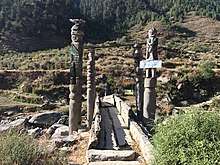
In the 11th century, a powerful empire of Khas people emerged in western Nepal whose territory at its highest peak included much of western Nepal as well as parts of western Tibet and Uttarakhand of India. By the 14th century, the empire had splintered into loosely associated Baise rajyas, literally 22 states as they were counted. The rich culture and language of the Khas people spread throughout Nepal and as far as Indo-China in the intervening centuries; their language, later renamed Nepali language, became the lingua franca of Nepal as well as much of North-east India.[46]
In south-eastern Nepal, Simraungarh annexed Mithila around 1100 CE, and the unified Tirhut stood as a powerful kingdom for more than 200 years,[52] even ruling over Kathmandu for a time.[53] After another 300 years of Muslim rule, Tirhut came under the control of the Sens of Makawanpur.[52] In the eastern hills, a confederation of Kirat principalities ruled the area between Kathmandu and Bengal.
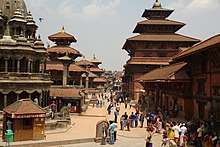
In the Kathmandu valley, the Mallas, who make several appearances in Nepalese history since ancient times, had established themselves in Kathmandu and Patan by middle of the 14th century. The Mallas ruled the valley first under the suzerainty of Tirhut, but established independent reign by late 14th century as Tirhut went into decline. In the late 14th century, Jayasthiti Malla introduced widespread socio-economic reforms, principal of which was the caste system. By dividing the indigenous non-Aryan Buddhist population into castes modelled after the four Varna system of Hinduism, he provided an influential model for the Sanskritization and Hinduization of the indigenous non-Hindu tribal populations in all principalities throughout Nepal. By the middle of the 15th century, Kathmandu had become a powerful empire which, according to Kirkpatrick, extended from Digarchi or Sigatse in Tibet to Tirhut and Gaya in India.[54] In the late 15th century, Malla princes divided their kingdom in four — Kathmandu, Patan and Bhaktapur in the valley and Banepa to the east. The competition for prestige among these brotherly kingdoms saw the flourishing of art and architecture in central Nepal, and the building of famous Kathmandu, Patan and Bhaktapur Durbar Squares; their division and mistrust led to their fall in the late 18th century, and ultimately, unification of Nepal into a modern state.[46][55]
Apart from one destructive sacking of Kathmandu in the early 13th century, Nepal remain largely untouched by the Muslim invasion of India that began in the 11th century. However, the Mughal period saw an influx of high-caste Hindus from India into Nepal. They soon intermingled with the Khas people and by the 16th century, there were about 50 Rajput-ruled principalities in Nepal, including the 22 baisi states and, to their east in west-central Nepal, 24 Chaubisi states. There emerged a view that Nepal remained the true bastion of unadulterated Hinduism at a time when Indian culture had been influenced by centuries of Mughal, followed by British rule. Gorkha, one of the Baisi states, emerged as an influential and ambitious kingdom with a reputation for justice, after it codified the first Hinduism-based laws in the Nepalese hills.[46]
Unification, expansion and consolidation
In the mid-18th century, Prithvi Narayan Shah, a Gorkha king, set out to put together what would become present-day Nepal. He embarked on his mission by securing the neutrality of the bordering mountain kingdoms. After several bloody battles and sieges, notably the Battle of Kirtipur, he managed to conquer the Kathmandu Valley in 1769.[56]
The Gorkha control reached its height when the North Indian territories of the Kumaon and Garhwal Kingdoms in the west to Sikkim in the east came under Nepalese control. A dispute with Tibet over the control of mountain passes and inner Tingri valleys of Tibet forced the Qing Emperor of China to start the Sino-Nepali War compelling the Nepali to retreat to their own borders in the north.[57] Rivalry between the Kingdom of Nepal and the East India Company over the control of states bordering Nepal eventually led to the Anglo-Nepali War (1815–16). At first, the British underestimated the Nepali and were soundly defeated until committing more military resources than they had anticipated needing. Thus began the reputation of Gurkhas as fierce and ruthless soldiers. The war ended in the Sugauli Treaty, under which Nepal ceded recently captured lands.[58][46]
Factionalism inside the royal family led to a period of instability. In 1846, a plot was discovered revealing that the reigning queen had planned to overthrow Jung Bahadur Kunwar, a fast-rising military leader. This led to the Kot massacre; armed clashes between military personnel and administrators loyal to the queen led to the execution of several hundred princes and chieftains around the country. Bir Narsingh Kunwar emerged victorious and founded the Rana dynasty, and came to be known as Jung Bahadur Rana. The king was made a titular figure, and the post of Prime Minister was made powerful and hereditary. The Ranas were staunchly pro-British and assisted them during the Indian Rebellion of 1857 (and later in both World Wars). In 1860 some parts of the western Terai region were gifted to Nepal by the British as a friendly gesture because of her military help to sustain British control in India during the rebellion (known as Naya Muluk, new country). In 1923, the United Kingdom and Nepal formally signed an agreement of friendship that superseded the Sugauli Treaty of 1816.[59]
The Hindu practice of Sati, in which a widow sacrificed herself in the funeral pyre of her husband, was banned in 1919, and slavery was officially abolished in 1924.[60] Rana rule was marked by tyranny, debauchery, economic exploitation and religious persecution.[61][62]
Nepal after 1950

In the late 1940s, newly emerging pro-democracy movements and political parties in Nepal were critical of the Rana autocracy. Following the success of Indian Independence Movement which Nepalese activists had taken part in, with India's support and cooperation of King Tribhuvan, Nepali Congress was successful in toppling the Rana regime, establishing a parliamentary democracy. After a decade of power wrangling between the king and the government, King Mahendra (ruled 1955–1972) scrapped the democratic experiment in 1960, and a "partyless" Panchayat system was made to govern Nepal. The political parties were banned and politicians imprisoned or exiled.[63]
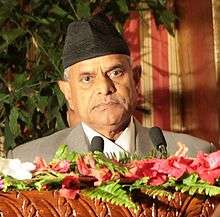
The Panchayat rule modernised the country, introducing reforms and developing infrastructure, but curtailed liberties and imposed heavy censorship. In 1990, the People's Movement forced King Birendra (ruled 1972–2001) to accept constitutional reforms and to establish a multiparty democracy.[63][64]
In 1996, the Maoist Party started a violent bid to replace the royal parliamentary system with a people's republic.[63] This led to the long Nepali Civil War and more than 16,000 deaths.[65] With the death of both the King and the Crown Prince in a massacre in the royal palace, King Birendra's brother Gyanendra inherited the throne in 2001[63] and subsequently assumed full executive powers aiming to quash the Maoist insurgency himself.[66]
The Maoist Party joined mainstream politics following the success of the peaceful democratic revolution of 2006;[67] Nepal became a secular state,[68] and on 28 May 2008, it was declared a Federal Republic,[67] ending its time-honoured status as the world's only Hindu Kingdom.[69] After a decade of instability and internal strife which saw two constituent assembly elections, the new constitution was promulgated on 20 September 2015, making Nepal a federal democratic republic divided into seven provinces.[70][71]
Geography
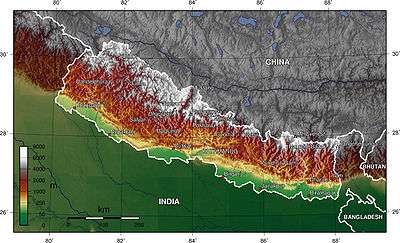
Nepal is of roughly trapezoidal shape, about 800 kilometres (500 mi) long and 200 kilometres (120 mi) wide, with an area of 147,516 km2 (56,956 sq mi). It lies between latitudes 26° and 31°N, and longitudes 80° and 89°E. Nepal's defining geological processes began 75 million years ago when the Indian plate, then part of the southern supercontinent Gondwana, began a north-eastward drift caused by seafloor spreading to its south-west, and later, south and south-east.[72] Simultaneously, the vast Tethyn oceanic crust, to its northeast, began to subduct under the Eurasian plate.[72] These dual processes, driven by convection in the Earth's mantle, both created the Indian Ocean and caused the Indian continental crust eventually to under-thrust Eurasia and to uplift the Himalayas.[72] The rising barriers blocked the paths of rivers creating large lakes, which only broke through as late as 100,000 years ago, creating fertile valleys in the middle hills like the Kathmandu Valley. In the western region, rivers which were too strong to be hampered, cut some of the world's deepest gorges.[73] Immediately south of the emerging Himalayas, plate movement created a vast trough that rapidly filled with river-borne sediment[74] and now constitutes the Indo-Gangetic Plain.[75] Nepal lies almost completely within this collision zone, occupying the central sector of the Himalayan arc, nearly one third of the 2,400 km (1,500 mi)-long Himalayas,[76][77][78][79][80][81] with a small strip of southernmost Nepal stretching into the Indo-Gangetic plain and two districts in the northwest stretching up to the Tibetan plateau.[73]

Nepal is divided into three principal physiographic belts known as Himal-Pahad-Terai.[lower-alpha 5] Himal is the mountain region containing snow and situated in the Great Himalayan Range; it makes up the northern part of Nepal. It contains the highest elevations in the world including 8,848 metres (29,029 ft) height Mount Everest (Sagarmāthā in Nepali) on the border with China. Seven other of the world's "eight-thousanders" are in Nepal or on its border with China: Lhotse, Makalu, Cho Oyu, Kangchenjunga, Dhaulagiri, Annapurna and Manaslu. Pahad is the mountain region that does not generally contain snow. The mountains vary from 800 to 4,000 metres (2,600 to 13,100 ft) in altitude, with progression from subtropical climates below 1,200 metres (3,900 ft) to alpine climates above 3,600 metres (11,800 ft). The Lower Himalayan Range, reaching 1,500 to 3,000 metres (4,900 to 9,800 ft), is the southern limit of this region, with subtropical river valleys and "hills" alternating to the north of this range. Population density is high in valleys but notably less above 2,000 metres (6,600 ft) and very low above 2,500 metres (8,200 ft), where snow occasionally falls in winter. The southern lowland plains or Terai bordering India are part of the northern rim of the Indo-Gangetic Plain. Terai is the lowland region containing some hill ranges. The plains were formed and are fed by three major Himalayan rivers: the Koshi, the Narayani, and the Karnali as well as smaller rivers rising below the permanent snowline. This region has subtropical to tropical climate. The outermost range of the foothills called Sivalik Hills or Churia Range, cresting at 700 to 1,000 metres (2,300 to 3,280 ft), marks the limits of the Gangetic Plain; however broad, low valleys called Inner Terai Valleys (Bhitri Tarai Upatyaka) lie north of these foothills in several places.
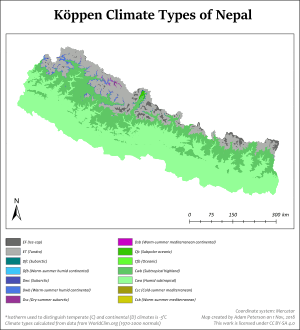
The Indian plate continues to move north relative to Asia at about 50 mm (2.0 in) per year.[82] This makes Nepal an earthquake prone zone, and periodic earthquakes that have devastating consequences present a significant hurdle to development. Erosion of the Himalayas is a very important source of sediment, which flows to the Indian Ocean.[83] Saptakoshi, in particular, carries huge amount of silt out of Nepal but sees extreme drop in Gradient in Bihar, causing severe floods and course changes, and is therefore, known as the sorrow of Bihar. Severe flooding and landslides cause deaths and disease, destroy farmlands and cripple the transport infrastructure of the country, during the monsoon season each year.
Nepal has five climatic zones, broadly corresponding to the altitudes. The tropical and subtropical zones lie below 1,200 metres (3,900 ft), the temperate zone 1,200 to 2,400 metres (3,900 to 7,900 ft), the cold zone 2,400 to 3,600 metres (7,900 to 11,800 ft), the subarctic zone 3,600 to 4,400 metres (11,800 to 14,400 ft), and the Arctic zone above 4,400 metres (14,400 ft). Nepal experiences five seasons: summer, monsoon, autumn, winter and spring. The Himalayas block cold winds from Central Asia in the winter and form the northern limits of the monsoon wind patterns.
Biodiversity
_data.jpg)
Nepal contains a disproportionately large diversity of plants and animals, relative to its size.[85][86] Nepal, in its entirety, forms the western portion of the eastern Himalayan biodiversity hotspot, with notable biocultural diversity.[87] The dramatic differences in elevation found in Nepal (60 m from sea level in the Terai plains, to 8,848 m Mount Everest)[88] result in a variety of biomes.[85] Eastern half of Nepal is richer in biodiversity as it receives more rain, compared to western parts, where arctic desert-type conditions are more common at higher elevations.[86] Nepal is a habitat for 4.0% of all mammal species, 8.9% of bird species, 1.0% of reptile species, 2.5% of amphibian species, 1.9% of fish species, 3.7% of butterfly species, 0.5% of moth species and 0.4% of spider species.[86] In its 35 forest-types and 118 ecosystems,[85][lower-alpha 6] Nepal harbours 2% of the flowering plant species, 3% of pteridophytes and 6% of bryophytes.[86]
Nepal's forest cover is 59,624 km2 (23,021 sq mi), 40.36% of the country's total land area, with an additional 4.38% of scrubland, for a total forested area of 44.74%, an increase of 5% since the turn of the millennium.[89] In the southern plains, Terai-Duar savanna and grasslands ecoregion contains some of the world's tallest grasses as well as Sal forests, tropical evergreen forests and tropical riverine deciduous forests.[90] In the lower hills (700 m – 2,000 m), subtropical and temperate deciduous mixed forests containing mostly Sal (in the lower altitudes), Chilaune and Katus, as well as subtropical pine forest dominated by Chir pine are common. The middle hills (2,000 m – 3,000 m) are dominated by Oak and Rhododendron. Subalpine coniferous forests cover the 3,000 m to 3,500 m range, dominated by Oak (particularly in the west), Eastern Himalayan fir, Himalayan pine and Himalayan hemlock; Rhododendron is common as well. Above 3,500 m in the west and 4,000 m in the east, coniferous trees give way to Rhododendron-dominated alpine shrubs and meadows.[86]
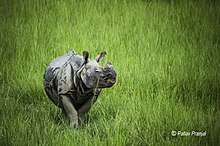
Among the notable trees, are the astringent Azadirachta indica, or neem, which is widely used in traditional herbal medicine,[91] and the luxuriant Ficus religiosa, or peepal,[92] which is displayed on the ancient seals of Mohenjo-daro,[93] and under which Gautam Buddha is recorded in the Pali canon to have sought enlightenment.[94]
Most of the subtropical evergreen broad-leaved forest of the lower himalayan region is descended from the tethyan tertiary flora.[95] As the Indian plate collided with Eurasia forming and raising the Himalayas, the arid and semi-arid mediterranean flora was pushed up and adapted to the more alpine climate over the next 40–50 million years.[95][96] The Himalayan biodiversity hotspot was the site of mass exchange and intermingling of the Indian and Eurasian species in the neogene.[97] One mammal species (Himalayan field mouse), two each of bird and reptile species, nine amphibian, eight fish and 29 butterfly species are endemic to Nepal.[86][lower-alpha 7]

Nepal contains 107 IUCN-designated threatened species, 88 of them animal species, 18 plant species and one species of "fungi or protist" group.[100] These include the endangered Bengal tiger, the Red panda, the Asiatic elephant, the Himalayan musk deer, the Wild water buffalo and the South Asian river dolphin,[101] as well as the critically endangered Gharial, the Bengal florican,[85][102] and the White-rumped Vulture, which has become nearly extinct by having ingested the carrion of diclofenac-treated cattle.[103] The pervasive and ecologically devastating human encroachment of recent decades has critically endangered Nepali wildlife. In response, the system of national parks and protected areas, first established in 1973 with the enactment of National Parks and Wildlife Conservation Act 1973,[104] was substantially expanded. Vulture restaurants[86] coupled with a ban on veterinary usage of diclofenac has seen a rise in the number of white-rumped vultures.[105][103] The community forestry program which has seen a third of the country's population directly participate in managing a quarter of the total forested area, has helped the local economies while reducing human-wildlife conflict.[106][107] The breeding programmes[108] coupled with community-assisted military patrols,[109] and a crackdown on poaching and smuggling, has seen poaching of critically endangered tigers and elephants as well as vulnerable rhinos, among others, go down to effectively zero, and their numbers have steadily increased.[110] Nepal has ten national parks, three wildlife reserves, one hunting reserve, three conservation areas and eleven buffer zones, covering a total area of 28,959.67 km2 (11,181.39 sq mi), or 19.67% of the total land area,[111] while ten wetlands are registered under the Ramsar Convention.[112]
Politics and government
Politics
 |  |
| Bidhya Devi Bhandari President |
Khadga Prasad Oli Prime Minister |
Nepal is a parliamentary republic with a multi-party system.[113] It has three political parties recognised in the federal parliament: Nepal Communist Party (NCP), Nepali Congress (NC),[113] and Janata Samajbadi Party, Nepal (JSPN).[113] Of the two major parties both of which officially espouse democratic socialism, NCP is considered leftist while Nepali Congress is considered centrist.[114] During most of the brief periods of democratic exercise in the 1950s and the 1990s, Nepali Congress held majority of seats in parliament; CPN (UML) was its competitor in the 1990s.[115] After the Maoists entered the political process in 2006, they emerged as the third largest party.[116] In the aftermath of the 2017 elections, the first one according to the new constitution, NCP, formed by the merger of CPN (UML) and CPN (Maoist Centre) has become the ruling party at the federal level and in six out of seven provinces.[117] The Madhesi coalition, comprising Samajbadi Party, Nepal and Rastriya Janata Party, Nepal, which lated merged to form JSPN, formed the provincial government in Province No. 2, though it has negligible presence in the rest of the country.[118][119][120] Though Nepali Congress has a significantly reduced representation, it is the only major opposition to the ruling communist party in all levels of government.[121]
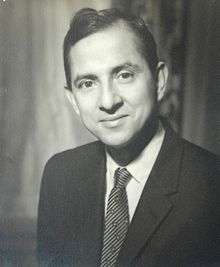
In the 1930s, a vibrant underground political movement rose in the capital, birthing Nepal Praja Parishad in 1936,[122] which was dissolved seven years later, following the execution of the four great martyrs. Around the same time, Nepalis involved in the Indian Independence Movement started organizing into political parties, leading to the birth of Nepali Congress and Communist Party of Nepal.[123] As communism was trying to find its footing, Nepali Congress was successful in overthrowing the Rana regime in 1951 and enjoyed overwhelming support of the electorate.[124] In the partyless Panchayat system initiated in 1962 by King Mahendra, monarchy loyalists took turns leading the government; political leaders remained underground, exiled or in prison.[122] A communist insurgency was crushed in its cradle in the 1970s, which led to the eventual coalescence of hitherto scattered communist factions under the United Left Front.
After the joint civil resistance launched by the United Left Front and Nepali Congress overthrew the Panchayat in 1990,[124][125] the Front became CPN (UML), adopted multi-party democracy, and in the brief period it was in government, introduced welfare programs that remain popular.[115] After the Maoist Party joined mainstream politics, in the aftermath of the peaceful revolution of 2006, it also adopted multi-party democracy as its official line. The transition period between 2006 and 2015 saw sustained protests from the newly formed ethnocentric nationalist movements, principal among them the Madhes Movement. RJPN and SPN advocating equal rights and self-governance for the Madhesi people became major political parties in the Terai, Province No. 2 in particular.[116][126][127][128]
Government
Nepal is governed according to the Constitution of Nepal. It defines Nepal as having multi-ethnic, multi-lingual, multi-religious, multi-cultural characteristics with common aspirations of people living in diverse geographical regions, and being committed to and united by a bond of allegiance to the national independence, territorial integrity, national interest, and prosperity of Nepal.[3]
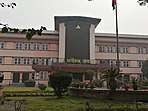
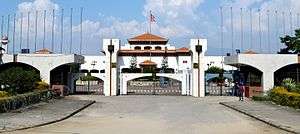
The Government of Nepal has three branches:[3]
- Executive: The form of governance is a multi-party, competitive, federal democratic republican parliamentary system based on plurality. The President appoints the parliamentary party leader of the political party with the majority in the House of Representatives as Prime Minister, who forms the Council of ministers that exercises the executive power.
- Legislature: The Legislature of Nepal, called the Federal Parliament, consists of the House of Representatives and the National Assembly. The House of Representatives consists of 275 members elected through a mixed electoral system, and has a term of five years. The National Assembly, consisting of 59 members elected by provincial electoral colleges, is a permanent house; a third of its members are elected every two years for a six-year term.[129]
- Judiciary: Nepal has a unitary three-tier independent judiciary that comprises the Supreme Court, the highest court in the land, headed by the Chief Justice, seven High Courts, one in each province, the highest court at the provincial level, and 77 district courts, one in each district. The municipal councils can convene local judicial bodies to resolve disputes and render non-binding verdicts in cases not involving actionable crime. The actions and proceedings of the local judicial bodies may be guided and countermanded by the district courts.[3]
Administrative divisions
| Province | Capital | Governor | Chief Minister | Districts | Area (km2) |
Population (2011) |
Density (people/km2) |
Human Development Index | Map |
|---|---|---|---|---|---|---|---|---|---|
| Province No. 1 | Biratnagar | Somnath Adhikari | Sher Dhan Rai | 14 | 25,905 km2 | 4,534,943 | 175 | 0.553 |  |
| Province No. 2 | Janakpur | Tilak Pariyar | Mohammad Lalbabu Raut | 8 | 9,661 km2 | 5,404,145 | 559 | 0.485 | 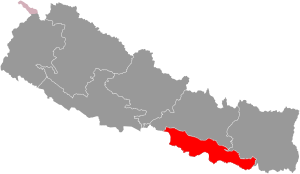 |
| Bagmati Pradesh | Hetauda | Bishnu Prasad Prasain | Dormani Poudel | 13 | 20,300 km2 | 5,529,452 | 272 | 0.560 | 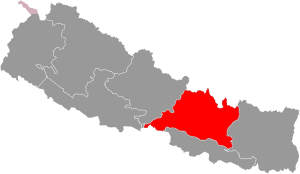 |
| Gandaki Pradesh | Pokhara | Amik Sherchan | Prithvi Subba Gurung | 11 | 21,504 km2 | 2,403,757 | 112 | 0.567 |  |
| Province No. 5 | Butwal | Dharmanath Yadav | Shankar Pokharel | 12 | 22,288 km2 | 4,499,272 | 219 | 0.519 | 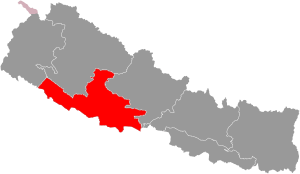 |
| Karnali Pradesh | Birendranagar | Govinda Prasad Kalauni | Mahendra Bahadur Shahi | 10 | 27,984 km2 | 1,570,418 | 41 | 0.469 | 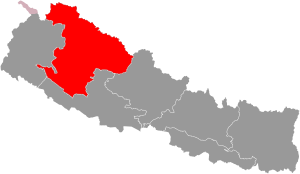 |
| Sudurpashchim Pradesh | Godawari | Sharmila Kumari Panta | Trilochan Bhatta | 9 | 19,915 km2 | 2,552,517 | 130 | 0.478 |  |
| Nepal | Kathmandu | President Bidhya Devi Bhandari |
Prime Minister Khadga Prasad Sharma Oli |
77 | 147,557 km2 | 26,494,504 | 180 | 0.579 | 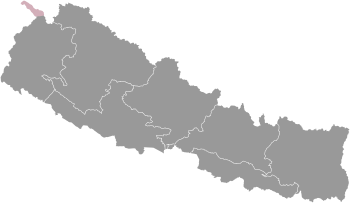 |
Nepal is a federal republic comprising 7 provinces. Each province is composed of 8 to 14 districts. The districts, in turn, comprise local units known as urban and rural municipalities.[3] There is a total of 753 local units which includes 6 metropolitan municipalities, 11 sub-metropolitan municipalities and 276 municipalities for a total of 293 urban municipalities, and 460 rural municipalities.[130] Each local unit is composed of wards. There are 6,743 wards in total.
The local governments enjoy executive and legislative as well as limited judicial powers in their local jurisdiction. The provinces have unicameral parliamentary Westminster system of governance. The local and provincial governments exercise some absolute powers and some powers shared with provincial and/or federal government. The district coordination committee, a committee composed of all elected officials from the local governments in the district, has a very limited role.[3][130]
Laws and law enforcement
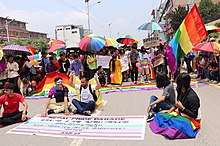
The Constitution of Nepal is the supreme law of the land, and any other laws contradicting it are automatically invalid to the extent of the contradiction.[131] The specific legal provisions are codified as Civil Code and Criminal Code, accompanied by Civil Procedure Code and Criminal Procedure Code respectively.[132] The Supreme Court is the highest authority in the interpretation of laws and it can direct the parliament to amend or enact new laws as required. Nepali laws are considered generally more progressive compared to other developing countries, and in some instances, many developed ones. Death penalty has been abolished.[133] Nepal also has made progress in LGBT rights and gender equality. It recognises marital rape and supports abortion rights; however, owing to a rise in sex-selective abortion, constraints have been introduced. Nepal is a signatory to the Geneva Convention, Conventions/Treaties on the prohibition of Biological, Chemical and Nuclear weapons,[134] International Labour Organization Fundamental Conventions, Treaty on the non-proliferation of nuclear weapons and the Paris climate accord. Some legal provisions, guided by socio-economic, cultural and religious sensibilities, remain discriminatory. There is gender-based discrimination against foreign nationals married to Nepali citizens.[lower-alpha 8] Paternal lineage of a person is valued and required in legal documents. Many laws remain unenforced in practice.
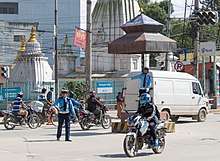
Nepal Police is the primary law enforcement agency. It is an independent organization under the command of the Inspector General, who is appointed by and reports to the Ministry of Home Affairs. In addition to maintaining law and order, it is responsible for management of road traffic, which is undertaken by Nepal Traffic Police. Nepal Armed Police Force, a separate paramilitary police organization, works in cooperation with Nepal police in routine security matters; it is intended for crowd control, counter-insurgency and anti-terrorism actions, and other internal matters where use of force may be necessary. The Crime Investigation Department of Nepal Police specializes in criminal investigation and forensic analysis.[136][137][138][139][140] The Commission for the Investigation of Abuse of Authority is an independent investigative agency that investigates and prosecutes cases related to corruption, bribery and abuses of authority. At 2.16 per 100,000 in 2016, Nepal's intentional homicide rate is much lower than average; police data indicates a steady increase in the crime rate in recent years.[141] Nepal was ranked 76 out of 163 countries in the Global Peace Index (GPI) in 2019.[142]
Foreign relations
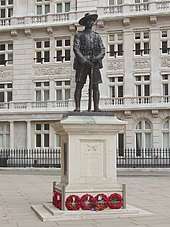
Nepal depends on diplomacy for national defence. It maintains a policy of neutrality between its neighbours, has amicable relations with other countries in the region, and has a policy of non-alignment at the global stage. Nepal is a member of SAARC, UN, WTO, BIMSTEC and ACD, among others. It has bilateral diplomatic relations with 167 countries and the EU,[143] has embassies in 30 countries[144] and six consulates,[145] while 25 countries maintain embassies in Nepal, and more than 80 others maintain non-residential diplomatic missions.[146] Nepal is one of the major contributors to the UN peacekeeping missions, having contributed more than 119,000 personnel to 42 missions since 1958.[147] Nepali people have a reputation for honesty, loyalty and bravery, which has led to them serving as legendary Gurkha warriors in the Indian and British armies for the last 200 years, with service in both world wars, India-Pakistan wars as well as Afghanistan and Iraq,[148] though Nepal was not directly involved in any of those conflicts, and winning the highest military awards, including the Victoria Cross and the Param Vir Chakra.[149]
Nepal pursues a policy of "balanced relations" with the two giant immediate neighbours, India and China;[150][151] the 1950 Treaty of Peace and Friendship with India provides for a much closer relationship.[152] Nepal and India share an open border with free movement of people, religious, cultural and marital ties. India is Nepal's largest trading partner, which it depends upon for all of its oil and gas, and a number of essential goods. Nepalis can own property in India, while Indians are free to live and work in Nepal.[153] Relations between India and Nepal, though very close, is "fraught with difficulties stemming from geography, economics, the problems inherent in big power-small power relations, and common ethnic, linguistic and cultural identities that overlap the two countries' borders".[154] Nepal established diplomatic relations with the People's Republic of China on 1 August 1955, and signed the Treaty of Peace and Friendship in 1960; relations since have been based on the Five Principles of Peaceful Coexistence. Nepal maintains neutrality in conflicts between China and India. It remains firmly committed to the One China Policy, and is known to curb anti-China activities from the Tibetan refugees in Nepal.[155][156] Citizens of both countries can cross the border and travel as far as 30 km without a visa.[157] China is viewed favourably in Nepal owing to the absence of any border disputes or serious interference in internal politics, coupled with its assistance in infrastructure development and aid during emergencies; favourability has increased since China helped Nepal during the 2015 economic blockade imposed by India.[158] Subsequently, China granted Nepal access to its ports for third-country trade, and Nepal joined China's Belt and Road Initiative.[159]
Nepal emphasises greater cooperation in South Asia and actively pushed for the establishment of SAARC, the South Asian Association for Regional Cooperation, the permanent secretariat of which, is hosted in Kathmandu.[160] Nepal was one of the first countries to recognise an independent Bangladesh, and the two countries seek to enhance greater cooperation, on trade and water management; seaports in Bangladesh, being closer, are seen as viable alternatives to India's monopoly on Nepal's third-country trade.[161] Nepal was the first South Asian country to establish diplomatic relations with Israel, and the countries enjoy a strong relationship;[162] it recognises the rights of the Palestinians, having voted in favour of its recognition at the UN and against the recognition of Jerusalem as Israel's capital.[163] Countries that Nepal maintains a close relationship with, include the most generous donors and development partners—the United States, the United Kingdom, Denmark, Japan and Norway, among others.[164]
Military and intelligence

The President is the supreme commander of the Nepalese Army; its routine management is handled by the Ministry of Defence. The military expenditure for 2018 was $398.5 million,[165] around 1.4% of GDP.[166] An almost exclusively ground infantry force, Nepal Army numbers at less than one hundred thousand;[167][168][169] recruitment is voluntary.[170] It has few aircraft, mainly helicopters, primarily used for transport, patrol, and search and rescue.[171] Directorate of Military Intelligence under Nepal Army serves as the military intelligence agency;[172] National Investigation Department tasked with national and international intelligence gathering, is independent.[167] Nepal Army is primarily used for routine security of critical assets, anti-poaching patrol of national parks, counterinsurgency, and search and rescue during natural disasters;[173] it also undertakes major construction projects.[174] There are no discriminatory policies on recruitment into the army, but it is dominated by men from elite Pahari warrior castes.[175][176]
Economy

Nepal's gross domestic product (GDP) for 2018 was estimated at $28.8 billion.[177] With an annual growth rate calculated at 6.3% in 2018,[178] and expected to reach 7.1% in 2019,[179] Nepal is one of the fastest growing economies in the world. However, the country ranks 165th in the world[lower-alpha 9] in nominal GDP per capita[180] and 162nd[lower-alpha 10] in GDP per capita at PPP.[181] Nepal has been a member of WTO since 23 April 2004.[182]
The 16.8-million-worker Nepali labour force is the 37th largest in the world.[183] The primary sector makes up 27.59% of GDP, the secondary sector 14.6%, and the tertiary sector 57.81%.[184] Nepal's foreign exchange remittances of US$8.1 billion in 2018, the 19th largest in the world and constituting 28.0% of GDP,[185] were contributed to its economy by millions of workers primarily in India, the middle east and East Asia, almost all of them unskilled labourers.[186][187] Major agricultural products include cereals (barley, maize, millet, paddy and wheat), oilseed, potato, pulses, sugarcane, jute, tobacco, milk and water buffalo meat.[188][189] Major industries include tourism, carpets, textiles, cigarettes, cement, brick, as well as small rice, jute, sugar and oilseed mills.[188] Nepal's international trade greatly expanded in 1951 with the establishment of democracy; liberalization began in 1985 and picked up pace after 1990. By the fiscal year 2016/17, Nepal's foreign trade amounted Rs 1.06 trillion, a twenty-three folds increase from Rs 45.6 billion in 1990/91. More than 60% of Nepal's trade is with India. Major exports include readymade garment, carpet, pulses, handicrafts, leather, medicinal herbs, and paper products, which account for 90% of the total. Major imports include various finished and semi-finished goods, raw materials, machinery and equipment, chemical fertilizers, electrical and electronic devices, petroleum products, gold, and readymade garments.[190] Inflation was at 4.5% in 2019.[179] Foreign exchange reserves were at US$9.5 billion in July 2019, equivalent to 7.8 months of imports.[179]
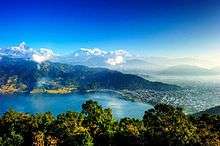
Nepal has made significant progress in poverty reduction bringing the population below the international poverty line (US$1.90 per person per day) from 15% in 2010 to just 9.3% in 2018, although vulnerability remains extremely high, with almost 32% of the population living on between US$1.90 and US$3.20 per person per day.[179] Nepal has made improvement in sectors like nutrition, child mortality, electricity, improved flooring and assets. Under the current trend, Nepal is expected to eradicate poverty within 20 years.[191][192] The agriculture sector is particularly vulnerable as it is highly dependent on the monsoon rains, with just 28% of the arable land being irrigated, As of 2014.[193] Agriculture employs 76% of the workforce, services 18%, and manufacturing and craft-based industry 6%.[194] Private investment, consumption, tourism and agriculture are the principal contributors to economic growth.[179]
The government's budget is about $13.71 billion (FY 2019/20);[195] expenditure of infrastructure development budget, most of it contributed by foreign aid, usually fails to meet the target.[196] The country receives foreign aid from the UK,[197][198] India, Japan, the US, the EU, China, Switzerland, and Scandinavian countries. The Nepali rupee has been tied to the Indian rupee at an exchange rate of 1.6 for many years. Per capita income is $1,004.[199] The distribution of wealth among the Nepalis is consistent with that in many developed and developing countries: the highest 10% of households control 39.1% of the national wealth and the lowest 10% control only 2.6%. European Union (EU) (46.13%), the US (17.4%), and Germany (7.1%) are its main export partners; they mainly buy Nepali ready-made garments (RMG).[200] Nepal's import partners include India (47.5%), the United Arab Emirates (11.2%), China (10.7%), Saudi Arabia (4.9%), and Singapore (4%).
Besides having landlocked, rugged geography, few tangible natural resources and poor infrastructure, the ineffective post-1950 government and the long-running civil war are also factors in stunting the country's economic growth and development.[201][202][203] Debt bondage even involving debtors' children has been a persistent social problem in the western hills and the Terai, with an estimated 234,600 people or 0.82% of the population considered as enslaved, by The Global Slavery Index in 2016.[204]
Tourism

Tourism is one of the largest and fastest-growing industries in Nepal, employing more than a million people and contributing 7.9% of the total GDP.[206] The number of international visitors crossed one million in 2018 for the first time (not counting Indian tourists arriving by land).[206][207] Nepal's share of visitors to South Asia is about 6%, and they spend much less on average, with Nepal sharing 1.7% of the earnings.[208] Premier destinations include Pokhara, the Annapurna trekking circuit and the four UNESCO world heritage sites—Lumbini, Sagarmatha National Park (home to Mount Everest), seven sites in the Kathmandu Valley collectively listed as one, and Chitwan National Park. Most of Nepal's mountaineering earning comes from Mount Everest, which is more accessible from the Nepalese side.
Nepal, officially opened to westerners in 1951, became a popular destination at the end of the hippie trail, during the 1960s and 1970s. The industry, disrupted by the civil war in the 1990s, has since recovered but faces challenges to growth, owing to a lack of proper facilities for high-end tourism termed the "infrastructure bottleneck", the flag carrier in shambles, and a handful of destinations properly developed and marketed. The home-stay tourism, in which cultural and eco-tourists stay as paying guests in the homes of indigenous people, has seen some success.[209]
Foreign employment
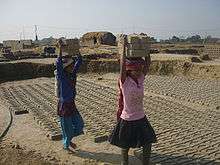
The rate of unemployment and underemployment exceeds half of the working-age population,[210] driving millions to seek employment abroad, mainly in India, the Gulf, and East Asia. Mostly unskilled, uneducated, and indebted to loan sharks, these workers are swindled by the manpower companies and sent to exploitative employers or war-ridden countries under fraudulent contracts.[211][212] They have their passports seized, to be returned when the employer grants them leave or terminates their contracts. Most do not get paid minimum wage,[213] and many are forced to forfeit all or part of the wages.[214] Many Nepalis work in extremely unsafe conditions; an average of two workers die each day.[215] Due to restrictions placed on women, many depend on traffickers to get out of the country, and end up victims of violence and abuse.[216] Many Nepalese are believed to be working under slavery-like conditions, and Nepal spends billions of rupees rescuing stranded workers, on remuneration to the indebted families of the dead, and in legal costs for those arrested in foreign countries.[217][218] Though millions have raised themselves out of poverty, due to a lack of entrepreneurial skills, the remittance is largely spent on real estate and consumption.[219][218]
Infrastructure
Energy
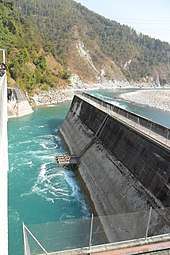
The bulk of energy in Nepal comes from biomass (80%) and imported fossil fuels (16%).[220] Most of the final energy consumption goes to the residential sector (84%) followed by transport (7%) and industry (6%); the transport and industry sectors have been expanding rapidly in recent years.[220] Except for some lignite deposits, Nepal has no known oil, gas or coal deposits.[220] All commercial fossil fuels (mainly oil, LPG and coal) are imported, spending 129% of the country's total export revenue.[221] Only about 1% of the energy need is fulfilled by electricity.[220] The perennial nature of Nepali rivers and the steep gradient of the country's topography provide ideal conditions for the development of hydroelectric projects. Estimates put Nepal's economically feasible hydro-power potential at approximately 42,000 MW.[220] However, Nepal has been able to exploit only about 1,100 MW. As most of it is generated from run-of-river (ROR) plants, the actual power produced is much lower in the dry winter months when peak demand can reach as high as 1,200 MW, and Nepal needs to import as much as 650 MW from India to meet the demands.[222] Major hydro-power projects suffer delays and setbacks.[223][224][225] Nepal's electrification rate (76%) is comparable to that of other countries in the region but there is significant disparity between the rural (72%) and urban (97%) areas.[220] The position of the power sector remains unsatisfactory because of high tariffs, high system losses, high generation costs, high overheads, over staffing, and lower domestic demand.[226]
Transportation
Nepal remains isolated from the world's major land, air and sea transport routes, although, within the country, aviation is in a better state, with 47 airports, 11 of them with paved runways;[227] flights are frequent and support a sizeable traffic. The hilly and mountainous terrain in the northern two-thirds of the country has made the building of roads and other infrastructure difficult and expensive. As of 2016, there were just over 11,890 km (7,388 mi) of paved roads, 16,100 km (10,004 mi) of unpaved roads, and just 59 km (37 mi) of railway line in the south.[227] As of 2018, all district headquarters (except Simikot) had been connected to the road network.[174] Most of the rural roads are not operable during the rainy season; even national highways regularly become inoperable.[228] Nepal depends almost entirely on assistance from countries like China, India and Japan, for building, maintenance and expansion of the road network. The only practical seaport of entry for goods bound for Kathmandu is Kolkata in India. The national carrier, Nepal Airlines, is in poor shape due to mismanagement and corruption, and has been blacklisted by the EU.[229] Internally, the poor state of development of the road system makes access to markets, schools, and health clinics a challenge.[201]
Communication
According to the Nepal Telecommunication Authority MIS August 2019 report, voice telephony subscription rate was at 2.70% of total population for fixed phones and 138.59% for mobile; 98% of all voice telephony was through mobile phones.[230] Similarly, while an estimated 14.52% had access to fixed broadband, an additional 52.71% were accessing the internet using their mobile data subscriptions; almost 15 million of them with 3G or better.[230] The mobile voice telephony and broadband market was dominated by two telecommunications companies, the state-owned Nepal Telecom (55%) and the private multinational, Ncell (40%).[230] Of the 21% market share enjoyed by fixed broadband, around 25% was again shared by Nepal Telecom, with the rest going to the private Internet Service Providers.[230] Although there is high disparity in penetration rate between the rural and urban areas, mobile service has reached 75 districts of the country covering 90% of land area, and broadband access is expected to reach 90% of the population by 2020.[227]
Media
As of 2019, the state operates three television stations as well as national and regional radio stations. There are 117 private TV channels and 736 FM radio stations licensed for operation, at least 314 of them, community radio stations.[227] According to the 2011 census, the percentage of households possessing radio was 50.82%, television 36.45%, cable TV 19.33%, and computer 7.28%.[231] According to the Press Council Nepal classification, as of 2017 of the 833 publications producing original content, ten national dailies and weeklies are rated A+ class.[232] In 2019, Reporters Without Borders ranked Nepal at 106th in the world in terms of press freedom.[233]
Demographics
The citizens of Nepal are known as Nepali or Nepalese. The Nepali are descendants of three major migrations from India, Tibet and North Burma, and the Chinese province of Yunnan via Assam. Among the earliest inhabitants were the Kirat of the eastern region, Newars of the Kathmandu Valley, aboriginal Tharus of the Terai plains and the Khas Pahari people of the far-western hills. Despite the migration of a significant section of the population to the Terai in recent years, the majority of Nepalese still live in the central highlands, and the northern mountains are sparsely populated.
Nepal is a multicultural and multiethnic country, home to 125 distinct ethnic groups, speaking 123 different mother tongues and following a number of indigenous and folk religions in addition to Hinduism, Buddhism, Islam and Christianity.[5] According to the 2011 census, Nepal's population was 26.5 million, almost a threefold increase from nine million in 1950. From 2001 to 2011, the average family size declined from 5.44 to 4.9. The census also noted some 1.9 million absentee people, over a million more than in 2001; most are male labourers employed overseas. This correlated with the drop in sex ratio to 94.2 from 99.8 for 2001.[234] The annual population growth rate was 1.35% between 2001 and 2011, compared to an average of 2.25% between 1961 and 2001; also attributed to the absentee population.[235]
Nepal is one of the ten least urbanized, and the ten fastest urbanizing countries in the world. As of 2014, an estimated 18.3% of the population lived in urban areas. Urbanization rate is high in the Terai, doon valleys of the inner Terai and valleys of the middle hills, but low in the high Himalayas. Similarly, the rate is higher in central and eastern Nepal compared to further west.[236] The capital, Kathmandu, nicknamed the "City of temples", is the largest city in the country and the cultural and economic heart. Other large cities in Nepal include Pokhara, Biratnagar, Lalitpur, Bharatpur, Birgunj, Dharan, Hetauda and Nepalgunj. Congestion, pollution and drinking water shortage are some of the major problems facing the rapidly growing cities, most prominently the Kathmandu Valley.
Language

Nepal's diverse linguistic heritage stems from three major language groups: Indo-Aryan, Tibeto-Burman, and various indigenous language isolates. The major languages of Nepal (percent spoken as native language) according to the 2011 census are Nepali (44.6%), Maithili (11.7%), Bhojpuri (6.0%), Tharu (5.8%), Tamang (5.1%), Nepal Bhasa (3.2%), Bajjika (3%) and Magar (3.0%), Doteli (3.0%), Urdu (2.6%), Awadhi (1.89%), and Sunwar. Nepal is home to at least four indigenous sign languages.
Descendent of Sanskrit, Nepali is written in Devanagari script. It is the official language and serves as lingua franca among Nepali of different ethnolinguistic groups. The regional languages Maithili, Awadhi and Bhojpuri are spoken in the southern Terai region; Urdu is common among Nepali Muslims. Varieties of Tibetan are spoken in and north of the higher Himalaya where standard literary Tibetan is widely understood by those with religious education. Local dialects in the Terai and hills are mostly unwritten with efforts underway to develop systems for writing many in Devanagari or the Roman alphabet.
Religion
The 2011 census reported that the religion with the largest number of followers in Nepal was Hinduism (81.3% of the population), followed by Buddhism (9%); the remaining were Islam (4.4%), Kirant (3.1%), Christianity (1.4%) and Prakriti or nature worship (0.5%).[237] By percentage of population, Nepal has the largest population of Hindus in the world.[238] Nepal was officially a Hindu Kingdom until recently, and Shiva was considered the guardian deity of the country.[239] Although many government policies throughout history have disregarded or marginalized minority religions, Nepalese societies generally enjoy religious tolerance and harmony among all religions, with only isolated incidents of religiously-motivated violence.[240][241]
Education
Nepal entered modernity in 1951 with a literacy rate of 5% and about 10,000 students enrolled in 300 schools.[242] By 2017, there were more than seven million students enrolled in 35,601 schools.[243] The overall literacy rate (for population age 5 years and above) increased from 54.1% in 2001 to 65.9% in 2011.[5] The net primary enrolment rate reached 97% by 2017,[244][245] however, enrolment was less than 60% at the secondary level (grades 9 –12),[246] and around 12% at the tertiary level.[246] Though there is significant gender disparity in overall literacy rate,[5] girls have overtaken boys in enrolment to all levels of education.[246] Nepal has eleven universities and four independent science academies.[243] Lack of proper infrastructures and teaching materials, and a high student-to-teacher ratio, as well as politicization of school management committees[247] and partisan unionization among both students and teachers,[248] present a hurdle to progress. Free basic education is guaranteed in the constitution but the programme lacks funding for effective implementation.[249] Government has scholarship programmes for girls and disabled students as well as the children of martyrs, marginalized communities and the poor.[250][251] Tens of thousands of Nepali students leave the country every year in search of better education and work, with half of them never returning.[252][253]
Health
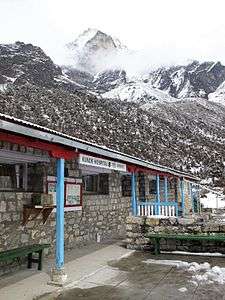
Health care services in Nepal are provided by both the public and private sectors. Life expectancy at birth is estimated at 71 years as of 2017, 153rd highest in the world,[254] up from 54 years in the 1990s.[255] Two-thirds of all deaths are due to non-communicable diseases; heart disease is the leading cause of death.[256] While sedentary lifestyle, imbalanced diet and consumption of tobacco and alcohol has contributed in the rise of non-communicable diseases, many lose their life to communicable and treatable diseases caused by poor sanitation and malnutrition due to a lack of education, awareness and access to healthcare services.[256][257]
Nepal has made great progress in maternal and child health. 95% of children have access to iodized salt, and 86% of children aged 6 – 59 months receive Vitamin A prophylaxis.[258] Stunting, underweight and wasting has been reduced significantly;[258] malnutrition, at 43% among children under five, is extremely high.[259] Anaemia in women and children increased between 2011 and 2016, reaching 41% and 53% respectively.[259] Low birth weight is at 27% while breastfeeding is at 65%.[259] Nepal has reduced maternal mortality rate to 229,[260] from 901 in 1990;[261][260] infant mortality is down to 32.2 per thousand live births compared to 139.8 in 1990.[262] Contraceptive prevalence rate is 53% but the disparity rate between rural and urban areas is high due to a lack of awareness and easy access.[263]
Progress in health is driven by strong government initiative in cooperation with NGOs and INGOs. Public health centres provide 72 essential medicines free of cost. In addition, the public health insurance plan initiated in 2016 which covers health treatments of up to Rs 50,000 for five members of a family, for a premium of Rs 2500 per year, has seen limited success, and is expected to expand.[264] By paying stipends for four antenatal visits to health centers and hospitalized delivery, Nepal decreased home-births from 81% in 2006[261] to 41% in 2016.[265] School meal programs have improved education as well as nutrition metrics among children.[266] Toilet building subsidies under the ambitious "one household-one toilet" program has seen toilet prevalence rate reach 99% in 2019, from just 6% in 1990.[267]
Immigrants and refugees
Nepal has a long tradition of accepting immigrants and refugees.[268] In modern times, Tibetans and Bhutanese have constituted a majority of refugees in Nepal. Tibetan refugees began arriving in 1959,[269] and many more cross into Nepal every year.[270] The Bhutanese Lhotsampa refugees began arriving in the 1980s and numbered more than 110,000 by the 2000s. Most of them have been resettled in third countries.[271] In late 2018, Nepal had a total of 20,800 confirmed refugees, 64% of them Tibetan and 31% Bhutanese.[272] Economic immigrants, and refugees fleeing persecution or war, from neighbouring countries, Africa and the Middle East, termed "urban refugees" because they live in apartments in the cities instead of refugee camps,[273][274][275] lack official recognition; the government facilitates their resettlement in third countries.[276]
Around 2,000 immigrants, half of them Chinese, applied for a work permit in 2018/19. The government lacks data on Indian immigrants as they do not require permits to live and work in Nepal;[277] Government of India puts the number of non-resident Indians in the country at 600,000.[278]
Culture

Society
Traditional Nepali society is sometimes defined by social hierarchy. The Nepali caste system embodies much of the social stratification and many of the social restrictions found in South Asia. Social classes are defined by more than a hundred endogamous hereditary groups, often termed as jātis, or "castes". Nepal declared untouchability to be illegal in 1963[279] and has since enacted other anti-discriminatory laws and social welfare initiatives. At the workplace and educational institutions in urban Nepal, caste-related identification has pretty much lost its importance.
Family values are important in the Nepali tradition, and multi-generational patriarchal joint families have been the norm in Nepal, though nuclear families are becoming common in urban areas. An overwhelming majority of Nepalis, with or without their consent, have their marriages arranged by their parents or other family elders. Marriage is thought to be for life, and the divorce rate is extremely low, with less than one in a thousand marriages ending in divorce.[280] Child marriages are common, especially in rural areas; many women wed before reaching 18.[281]
Many Nepali festivals are religious in origin. The best known include: Dashain, Tihar, Teej, Chhath, Maghi, Sakela, Holi, Eid ul-Fitr, Christmas, and the Nepali new year.
Symbols
| Flag | Flag of Nepal |
|---|---|
| Emblem | Emblem of Nepal |
| Language | All mother-tongues of Nepal |
| Anthem | Sayaun Thunga Phulka |
| Currency | रू (Nepalese rupee) |
| Mammal | Cow[282] |
| Bird | Himalayan monal |
| Flower | Rhododendron arboreum[283] |
| Sport | Volleyball[284] |
| Colour | Crimson |
The emblem of Nepal depicts the snowy Himalayas, the forested hills, and the fertile Terai, supported by a wreath of rhododendrons, national flag at the crest and in the foreground, a plain white map of Nepal with a man's and woman's right hands joining to signify gender equality just below it. At the bottom is the national motto of Nepal, a Sanskrit quote of patriotism attributed in Nepali folklore to Lord Rama, written in Devanagari script—"Mother and motherland are greater than heaven".
Nepal's flag is the only national flag in the world that is not rectangular in shape.[285] The constitution contains instructions for a geometric construction of the double-pennant flag.[286] According to its official description, the crimson in the flag stands for victory in war or courage, and is also the colour of the rhododendron. The flag's blue border signifies Nepali people's desire for peace. The moon on the flag is a symbol of the peaceful and calm nature of Nepalis, while the sun represents the aggressiveness of Nepali warriors.
The president is the symbol of national unity. The martyrs are the symbols of patriotism. Commanders of the Anglo-Nepalese war, Amar Singh Thapa, Bhakti Thapa, and Balbhadra Kunwar are considered war heroes. A special designation of "National hero" has been conferred to 16 people from Nepal's history for their exceptional contributions to the prestige of Nepal. Prithvi Narayan Shah, the founder of modern Nepal, is held in high regard and considered "Father of the Nation" by many.[287][288]
Art and architecture

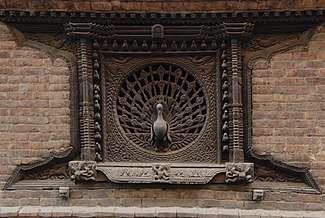
The oldest known examples of architecture in Nepal are stupas of early Buddhist constructions in and around Kapilvastu in south-western Nepal, and those constructed by Ashoka in the Kathmandu Valley c. 250 BCE. The characteristic architecture associated exclusively with Nepal was developed and refined by Newa artisans of the Kathmandu Valley starting no later than the Lichchhavi period. A Tang dynasty Chinese travel book, probably based on records from c. 650 CE, describes contemporary Nepali architecture, predominantly built with wood, as rich in artistry, as well as wood and metal sculpture. It describes a magnificent seven-storied pagoda in the middle of a palace, with copper-tiled roofs, its balustrade, grills, columns and beams set about with fine and precious stones, and four golden sculptures of Makaras in the four corners of the base spouting water from their mouths like a fountain, supplied by copper pipes connected to the runnels at the top of the tower. Later Chinese chronicles describe Nepal's king's palace as an immense structure with many roofs, suggesting that Chinese were not yet familiar with the pagoda architecture, which has now become one of the chief characteristic of Chinese architecture. A typical pagoda temple is built with wood, every piece of it finely carved with geometrical patterns or images of gods, goddesses, mythical beings and beasts. The roofs usually tiled with clay, and sometimes gold plated, diminish in proportion successively until the topmost roof is reached which is itself ensigned by a golden finial. The base is usually composed of rectangular terraces of finely carved stone; the entrance is usually guarded by stone sculptures of conventional figures. Bronze and copper craftsmanship observable in the sculpture of deities and beasts, decorations of doors and windows and the finials of buildings, as well as items of every day use is found to be of equal splendour. The most well-developed of Nepali painting traditions is the thanka or paubha painting tradition of Tibetan Buddhism, practised in Nepal by the Buddhist monks and Newar artisans. Changu Narayan Temple, built c. 4th century CE has probably the finest of Nepali woodcraft; the Kathmandu, Patan and Bhaktapur Durbar Squares are the culmination of Nepali art and architecture, showcasing Nepali wood, metal and stone craftsmanship refined over two millennia.[290]
The "ankhijhyal" window, that allow a one-way view of the outside world, is an example of unique Nepali woodcraft, found in building structures, domestic and public alike, ancient and modern. Many cultures paint the walls of their homes with regular patterns, figures of gods and beasts and religious symbols; others paint their walls plain, often with clay or chernozem contrasted with yellow soil or limestone. The roofs of religious as well as domestic structures project considerably, presumably to provide protection from the sun and the rain. The timber of domestic structures are finely carved as with their religious counterparts.[290]
Literature and the performing arts
Nepal's literature was closely intertwined with that of the rest of South Asia until its unification into a modern kingdom. Literary works, which were written in Sanskrit by Brahmin priests educated and sometimes also based in Varanasi, included religious texts and other fantasies involving kings, gods and demons.[291] The oldest extant Nepali language text is dated to the 13th century but except for the epigraphic material, Nepali language literature older than the 17th century haven't been found. However, Newar literature dates back almost 500 years.[288] The modern history of Nepali literature begins with Bhanubhakta Acharya (1814-1868), who for the first time composed major and influential works in Nepali, the language accessible to the masses, most prominently, the Bhanubhakta Ramayana, a translation of the ancient Hindu epic.[291] By the end of the nineteenth century, Motiram Bhatta had published print editions of the works of Acharya, and through his efforts, single-handedly popularised and propelled Nepali language literature into modernity.[288] By the mid-twentieth century, Nepali literature was no longer limited to the Hindu literary traditions. Influenced by western literary traditions, writers in this period started producing literary works addressing the contemporary social problems,[292] while many others continued to enrich Nepali poetic traditions with authentic Nepali poetry. Newar literature also emerged as a premier literary tradition. After the advent of democracy in 1951, Nepali literature flourished. Literary works in many other languages began to be produced. Nepali literature continued to modernise, and in recent years, has been strongly influenced by the post civil-war Nepali experience as well as global literary traditions.[293][294][295][288]
Maruni, Lakhey, Sakela, Kauda and Tamang Selo are some examples of the traditional Nepali music and dance in the hilly regions of Nepal.
Nepali film industry is known as "Kollywood".[296]
Nepal Academy is the foremost institution for the promotion of arts and culture in Nepal, established in 1957.[288]
Clothing
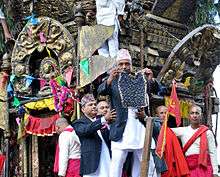
The most widely worn traditional dress in Nepal, for both women and men, from ancient times until the advent of modern times, was draped.[297] For women, it eventually took the form of a sari, a single long piece of cloth, famously six yards long, and of width spanning the lower body.[297] The sari is tied around the waist and knotted at one end, wrapped around the lower body, and then over the shoulder.[297] In its more modern form, it has been used to cover the head, and sometimes the face, as a veil,[297] particularly in the Terai. It has been combined with an underskirt, or the petticoat, and tucked in the waistband for more secure fastening. It is worn with a blouse, or cholo, which serves as the primary upper-body garment, the sari's end, passing over the shoulder, now serving to obscure the upper body's contours, and to cover the midriff.[297] Cholo-sari has become the attire of choice for formal occasions, official environs and festive gatherings. In its more traditional form, as part of traditional dresses and as worn in daily life while performing household chores or labour, it takes the form of a fariya or gunyu, usually shorter than a sari in length as well as breadth, and all of it wrapped around the lower body.
For men, a similar but shorter length of cloth, the dhoti, has served as a lower-body garment.[298] It too is tied around the waist and wrapped.[298] Among the Aryans, it is also wrapped once around each leg before being brought up through the legs to be tucked in at the back. Dhoti or its variants, usually worn over a langauti, constitute the lower-body garment in the traditional clothing of Tharus, Gurungs and Magars as well as the Madhesi people, among others. Other forms of traditional apparel that involve no stitching or tailoring are the Patukas (a length of cloth wrapped tightly over the waist by both sexes as a waistband, a part of most traditional Nepali costumes, usually with a Khukuri tucked into it when worn by men), scarves like Pachhyauras and majetros and shawls like the Newar Ga and Tibetan khata, Ghumtos (the wedding veils) and various kinds of turbans (scarves worn around the head as a part of a tradition, or to keep off the sun or the cold,[298] called a Pheta, Pagri or Sirpau).
Until the beginning of the first millennium CE, the ordinary dress of people in South Asia was entirely unstitched.[299] The arrival of the Kushans from Central Asia, circa 48 CE, popularised cut and sewn garments in the style of Central Asia.[299] The simplest form of sewn clothing, Bhoto (a rudimentary vest), is a universal unisex clothing for children, and traditionally the only clothing children wear until they come of age and are given adult garb, sometimes in a ceremonial rite of passage, such as the gunyu-choli ceremony for Hindu girls. Men continue to wear bhoto through adulthood. Upper body garment for men is usually a vest such as the bhoto, or a shirt similar to the Kurta, such as Daura, a closed-necked double-breasted long shirt with five pleats and eight strings that serve to tie it around the body. Suruwal, simply translated as a pair of trousers, is an alternative to and, more recently, replacement for dhoti, kachhad (Magars) or Lungi (Tharus); it is traditionally much wider above the knees but tapers below, to fit tightly at the ankles, and is tied to the waist with a drawstring. Modern cholos worn with sarees are usually half-sleeved and single-breasted, and do not cover the midriff. The traditional one called the chaubandi cholo, like the daura, is full-sleeved, double-breasted with pleats and strings, and extends down to the patuka, covering the midriff.
Daura-Suruwal and Gunyu-Cholo were the national dresses for men and women respectively until 2011 when they were removed to eliminate favouritism.[300] Traditional dresses of many pahari ethnic groups are Daura-Suruwal or similar, with patuka, a dhaka topi and a coat for men, and Gunyu-cholo or similar, with patuka and sometimes a scarf for women. For many other groups, men's traditional dresses consist of a shirt or a vest, paired with a dhoti, kachhad or lungi. In the high himalayas, the traditional dresses are largely influenced by Tibetan culture. Sherpa women wear the chuba with the pangi apron, while Sherpa men wear shirts with stiff high collar and long sleeves called tetung under the chuba. Tibetan Xamo Gyaise hats of the Sherpas, dhaka topi of pahari men and tamang round caps are among the more distinctive headwears.
Married Hindu women wear tika, sindur, pote and red bangles. Jewellery of gold and silver, and sometimes precious stones, are common. Gold jewellery includes Mangalsutras and tilaharis worn with the pote by the Hindus, Samyafung (a huge gold flower worn on the head) and Nessey (huge flattened gold earrings) worn by the Limbus, and Sirphuli, Sirbandhi and Chandra worn by the Magars. Tharu women can wear as much as six kilograms of silver in jewellery, which includes Mangiya worn on the head, tikuli the forehead, and kanseri and tikahamala around the neck.[301]
In the last 50 years, fashions have changed a great deal in Nepal. Increasingly, in urban settings, the sari is no longer the apparel of everyday wear, transformed instead into one for formal occasions. The traditional kurta suruwal is rarely worn by younger women, who increasingly favour jeans. The dhoti has largely been reduced to the liturgical vestment of shamans and Hindu priests.
Cuisine

Nepali cuisine consists of a wide variety of regional and traditional cuisines. Given the range of diversity in soil type, climate, culture, ethnic groups, and occupations, these cuisines vary substantially from each other, using locally available spices, herbs, vegetables, and fruit.[302] The Columbian exchange had brought the potato, the tomato, maize, peanuts, cashew nuts, pineapples, guavas, and most notably, chilli peppers, to South Asia. Each became staples of use.[303] The cereals grown in Nepal, their choice, times, and regions of planting, correspond strongly to the timing of Nepal's monsoons,[304] and the variations in altitude. Rice and wheat are mostly cultivated in the terai plains and well-irrigated valleys, and maize, millet, barley and buckwheat in the lesser fertile and drier hills.[302][305]
The foundation of a typical Nepali meal is a cereal cooked in plain fashion, and complemented with flavourful savoury dishes.[306] The latter includes lentils, pulses and vegetables spiced commonly with ginger and garlic, but also more discerningly with a combination of spices that may include coriander, cumin, turmeric, cinnamon, cardamon, jimbu and others as informed by culinary conventions.[306] In an actual meal, this mental representation takes the form of a platter, or thali, with a central place for the cooked cereal, peripheral ones, often in small bowls, for the flavourful accompaniments, and the simultaneous, rather than piecemeal, ingestion of the two in each act of eating, whether by actual mixing—for example of rice and lentils—or in the folding of one—such as bread—around the other, such as cooked vegetables.[306] Dal-bhat, centred around steamed rice is the most common example.[307] as well as dairy and sometimes meat, is the most common and prominent example. The unleavened flat bread made from wheat flour called chapati occasionally replaces the steamed rice, particularly in the Terai, while Dhindo, prepared by boiling corn, millet or buckwheat flour in water, continuously stirring and adding flour until thick, almost solid consistency is reached, is the main substitute in the hills and mountains. Tsampa, flour made from roasted barley or naked barley, is the main staple in the high himalayas. Throughout Nepal, fermented, then sun-dried, leafy greens called Gundruk, are both a delicacy and a vital substitute for fresh vegetables in the winter.[305]

A notable feature of Nepali food is the existence of a number of distinctive vegetarian cuisines, each a feature of the geographical and cultural histories of its adherents.[308] The appearance of ahimsa, or the avoidance of violence toward all forms of life in many religious orders early in South Asian history, especially Upanishadic Hinduism, Buddhism and Jainism, is thought to have been a notable factor in the prevalence of vegetarianism among a segment of Nepal's Hindu and Buddhist populations, as well as among Jains.[308] Among these groups, strong discomfort is felt at thoughts of eating meat.[309] Though per capita meat consumption is low in Nepal, the proportion of vegetarianism is not high as in India, due to the prevalence of Shaktism, of which animal sacrifice is a prominent feature.[310]
Nepali cuisines possess their own distinctive qualities to distinguish these hybrid cuisines from both their northern and southern neighbours.[311][307] Nepali cuisines, with generally tomato-based, leaner curries, are lighter than their cream-based Indian counterparts, and Nepali momo dumplings are heavily spiced compared to their northern counterparts.[307] Newar cuisine, one of the richest and most influential in Nepal, is more elaborate and diverse than most, as Newar culture developed in the highly fertile and prosperous Kathmandu valley.[302] A typical Newar cuisine can comprise more than a dozen dishes of cereals, meat, vegetable curries, chutneys and pickles. Kwanti (sprouted beans soup), chhwela (ground beef), chatamari, (rice flour crepe), bara (fried lentil cake), kachila (marinated raw minced beef), samaybaji (centred around flattened rice), lakhaamari and yomuri are among the more widely recognised.[307][312] Juju dhau, a sweet yoghurt originating in Bhaktapur, is also famous.[307] Thakali cuisine is another well-known food tradition which seamlessly melds the Tibetan and the Indian with variety in ingredients, especially the herbs and spices.[302] In the Terai, Bagiya is a rice flour dumpling with sweets inside, popular among the Tharu and Maithil people. Various communities in the Terai make sidhara (sun-dried small fish mixed with taro leaves) and biriya (lentil paste mixed with taro leaves) to stock for the monsoon floods.[302] Selroti, kasaar, fini and chaku are among the sweet delicacies. Rice pulau or sweet rice porridge called kheer are usually the main dish in feasts.[305] Tea and buttermilk (fermented milk leftover from churning butter from yoghurt) are common non-alcoholic drinks. Almost all janajati communities have their own traditional methods of brewing alcohol. Raksi (traditional distilled alcohol), jaand (rice beer), tongba (millet beer) and chyaang are the most well-known.
Sports and recreation
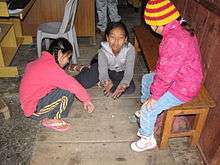
Nepali indigenous sports, like dandi biyo and kabaddi which were considered the unofficial national sports until recently,[313] are still popular in rural areas.[314] Despite efforts, standardization and development of dandi biyo has not been achieved,[315][316] while Kabaddi, as a professional sport, is still in its infancy in Nepal.[317] Bagh-chal, an ancient board game that's thought to have originated in Nepal, can be played on chalk-drawn boards, with pebbles, and is still popular today.[318][319] Ludo, snakes and ladders and carrom are popular pastimes.[320] Chess is also played.[314] Volleyball was declared as the national sport of Nepal in 2017.[313] Popular children's games include versions of tag,[314] knucklebones,[314] hopscotch, Duck, duck, goose[314] and lagori, while marbles,[314] top, hoop rolling and gully cricket are also popular among boys. Rubber bands, or ranger bands cut from tubes in bike tyres, make a multi-purpose sporting equipment for Nepali children, which may be bunched or chained together, and used to play dodgeball, cat's cradle, jianzi[314] and a variety of skipping rope games.[314]
Football and cricket are popular professional sports.[323] Nepal is competitive in football in the South Asia region but has never won the SAFF championships, the regional tournament.[324][325] It usually ranks in the bottom quarter in the FIFA world rankings.[326] Nepal has had success in cricket and holds the elite ODI status,[327][328] consistently ranking in the Top 20 in the ICC ODI and T20I rankings.[329][330] Nepal has had some success in athletics and martial arts, having won many medals at the South Asian Games and some at the Asian games.[331] Nepal has never won an olympic medal.[332] Sports like basketball, volleyball, futsal, wrestling, competitive bodybuilding[332][333] and badminton are also gaining in popularity.[314] Women in football, cricket, athletics, martial arts, badminton and swimming have found some success.[334][332] Nepal also fields players and national teams in several tournaments for the differently abled, most notably in men's[335] as well as women's blind cricket.[336]
The only international stadium in the country is the multi-purpose Dasarath Stadium where the men and women national football teams play their home matches.[337] Since the formation of the national team, Nepal has played its home matches of cricket at Tribhuvan University International Cricket Ground.[338] Nepal police, Armed police force and Nepal army are the most prolific producers of national players, and aspiring players are known to join armed forces, for the better sporting opportunities they can provide.[339][340] Nepali sports is hindered by a lack of infrastructure,[341] funding,[335] corruption, nepotism and political interference.[331][342][343] Very few players are able to make a living as professional sportspeople.[337][344]
See also
Notes
- The entire territory controlled by the monarch seated in Kathmandu at any given time would also be referred to as Nepal. Thus, at times, only the Kathmandu valley was considered Nepal while at other times, Nepal would encompass an area comparable to and largely overlapping with the modern state of Nepal[19]
- The word pala in Pali language means to protect. Consequently, Nepala translates to protected by Ne.
- Nepalamahatmya, of 30 chapters about the Nepal Tirtha (pilgrimage) region, is a regional text that claims to be a part of the Skanda Purana, the largest Mahāpurāṇa.
- On Samudragupta's Allahabad Pillar, Nepal is mentioned as a border country.
- This trichotomy is a prominent feature of Nepali discourse and is represented in the Emblem of Nepal, with blue and white peaks signifying Himal, green hills below them signifying Pahad and the yellow strip at the bottom signifying the Terai belt.
- 198 ecological types were first proposed in 1976, which was further revised and reduced to 118, which was further reduced by IUCN to 59 in 1998, which was further reduced to 36 in 2002. As this issue has yet to be settled, the 35-forest-type classification is generally preferred to the ecological categorization.[86]
- According to the 2019 IUCN red list, two species of mammals, one bird species and three amphibian species are endemic to Nepal.[98]
- However, same-sex marriage with foreign nationals occurring in a jurisdiction that recognises same-sex marriage is now recognised in Nepal, for eligibility to obtain a "non-tourist visa" as dependent of a Nepali citizen, by verdict of the Supreme Court in 2017, as the laws don't make sex-specific distinction in provisions relating to the rights of foreign nationals married to Nepali citizens.[135]
- October 2019, IMF update, excludes Somalia and Syria
- October 2019, IMF update; excludes Somalia, Syria and Venezuela
References
- "Nepal | Facts, History & News". www.infoplease.com. Retrieved 29 June 2020.
- "Nepal | Culture, History, & People". Encyclopedia Britannica. Retrieved 29 June 2020.
- "नेपालको संविधान २०७२" [Constitution of Nepal 2015] (pdf). 20 September 2015. Archived (PDF) from the original on 8 August 2019. Retrieved 16 July 2019 – via Nepal Law Commission.
- Mandal, Bidhi; Nayak, Ravi (9 June 2019). "Why English?". Republica. Retrieved 17 April 2020.
- 2011 National Census, p. 4.
- "President Bhandari administers oath of office to Oli". The Rising Nepal. 15 February 2020. Retrieved 17 April 2020.
- "Newly elected HoR Speaker Agni Sapkota takes oath of office". The Himalayan Times. 27 January 2020. Retrieved 13 February 2020.
- "Cholendra Shumsher JB Rana confirmed as Chief Justice". The Himalayan Times. 1 January 2019. Retrieved 17 April 2020.
- "History Of Nepal". Ministry of Foreign Affairs (Nepal). Retrieved 17 April 2020.
- ""World Population prospects – Population division"". population.un.org. United Nations Department of Economic and Social Affairs, Population Division. Retrieved 9 November 2019.
- ""Overall total population" – World Population Prospects: The 2019 Revision" (xslx). population.un.org (custom data acquired via website). United Nations Department of Economic and Social Affairs, Population Division. Retrieved 9 November 2019.
- 2011 National Census, p. 1.
- "Report for Selected Countries and Subjects". IMF. Retrieved 15 April 2020.
- "Gini Index (World Bank Estimate) - Nepal". World Bank. Archived from the original on 8 June 2014. Retrieved 16 April 2020.
- "Human Development Report 2019" (PDF). United Nations Development Programme. 2019. Retrieved 16 April 2020.
- "Voltage, Frequency and Power Factor of Electricity", Electricity Rules, 2050 (1993) (Regulation), 1993, retrieved 17 April 2020 – via Nepal Law Commission
- "Nepal | Definition of Nepal by Oxford Dictionary on Lexico.com also meaning of Nepal". Lexico Dictionaries | English. Retrieved 23 July 2020.
- "CIA – The World Factbook". CIA. Archived from the original on 29 December 2010. Retrieved 5 December 2012.
- Singh, Upinder (2008). A history of ancient and early medieval India : from the Stone Age to the 12th century. New Delhi: Pearson Longman. p. 477. ISBN 9788131716779.
- Malla, Kamal P. (1983). "Nepāla: Archaeology of the Word" (PDF). The Nepal Heritage Society Souvenir for PATA Conference. Kathmandu. pp. 33–39. Archived from the original on 22 March 2012. Retrieved 5 May 2011.
- Prasad, Ishwari (1996). The Life and Times of Maharaja Juddha Shumsher Jung Bahadur Rana of Nepal. New Delhi: Ashish Publishing House. ISBN 817024756X – via Google Books.
- Hasrat, Bikram Jit (1970). History of Nepal: As told by its own and contemporary chroniclers. Hoshiarpur. p. 7.
- Lassen, Christian (1847–1861). Indische Alterthumskunde [Indian Archaeology].
- Levi, Sylvain (1905). Le Nepal : Etude Historique d'Un Royaume Hindou. 1. Paris: Ernest Leroux. pp. 222–223.
- Majupuria, Trilok Chandra; Majupuria, Indra (1979). Glimpses of Nepal. Maha Devi. p. 8.
- Turner, Ralph L. (1931). A Comparative and Etymological Dictionary of the Nepali Language. London: Routledge and Kegan Paul. Archived from the original on 14 July 2012. Retrieved 8 May 2011.
- Hodgson, Brian H. (1874). Essays on the Languages, Literature and Religion of Nepal and Tibet. London: Trübner & Co. Archived from the original on 11 November 2012. Retrieved 8 May 2011. Page 51.
- Chatterji, Suniti Kumar (1974). Kirata-Jana-Krti: The Indo-Mongoloids: Their Contribution to the History and Culture of India (2 ed.). Calcutta: The Asiatic Society. p. 64.
- Dyson, Tim (2018). A Population History of India: From the First Modern People to the Present Day. Oxford University Press. p. 1. ISBN 978-0-19-882905-8. Quote: "Modern human beings—Homo sapiens—originated in Africa. Then, intermittently, sometime between 60,000 and 80,000 years ago, tiny groups of them began to enter the north-west of the Indian subcontinent. It seems likely that initially they came by way of the coast. ... it is virtually certain that there were Homo sapiens in the subcontinent 55,000 years ago, even though the earliest fossils that have been found of them date to only about 30,000 years before the present. (page 1)"
- Michael D. Petraglia; Bridget Allchin (22 May 2007). The Evolution and History of Human Populations in South Asia: Inter-disciplinary Studies in Archaeology, Biological Anthropology, Linguistics and Genetics. Springer Science + Business Media. p. 6. ISBN 978-1-4020-5562-1. Quote: "Y-Chromosome and Mt-DNA data support the colonization of South Asia by modern humans originating in Africa. ... Coalescence dates for most non-European populations average to between 73–55 ka."
- Fisher, Michael H. (2018). An Environmental History of India: From Earliest Times to the Twenty-First Century. Cambridge University Press. p. 23. ISBN 978-1-107-11162-2. Quote: "Scholars estimate that the first successful expansion of the Homo sapiens range beyond Africa and across the Arabian Peninsula occurred from as early as 80,000 years ago to as late as 40,000 years ago, although there may have been prior unsuccessful emigrations. Some of their descendants extended the human range ever further in each generation, spreading into each habitable land they encountered. One human channel was along the warm and productive coastal lands of the Persian Gulf and northern Indian Ocean. Eventually, various bands entered India between 75,000 years ago and 35,000 years ago (page 23)"
- Petraglia, Michael D.; Allchin, Bridget (2007). "Human evolution and culture change in the Indian subcontinent". In Michael Petraglia; Bridget Allchin (eds.). The Evolution and History of Human Populations in South Asia: Inter-disciplinary Studies in Archaeology, Biological Anthropology, Linguistics and Genetics. Springer Publishing. p. 6. ISBN 978-1-4020-5562-1.
- Corvinus, Gudrun. "The Prehistory of Nepal (A summary of the results of 10 years research)" (PDF). Kathmandu: Nepal Research Center. Retrieved 3 March 2020. Cite journal requires
|journal=(help) - Coningham, Robin; Young, Ruth (2015). The Archaeology of South Asia: From the Indus to Asoka, c. 6500 BCE – 200 CE. Cambridge University Press. pp. 104–5. ISBN 978-0-521-84697-4.
- Kulke, H.; Rothermund, D. (1 August 2004). A History of India. 4th. Routledge. pp. 21–3. ISBN 978-0-415-32920-0.
- Singh, U. (2009). A History of Ancient and Medieval India: From the Stone Age to the 12th Century. Delhi: Longman. p. 181. ISBN 978-81-317-1677-9.
- "The Prehistory of Nepal" (PDF).
- Krishna P. Bhattarai (2009). Nepal. Infobase publishing. ISBN 9781438105239.
- Wang, Hua-Wei; Li, Yu-Chun; Sun, Fei; Zhao, Mian; Mitra, Bikash; Chaudhuri, Tapas Kumar; Regmi, Pasupati; Wu, Shi-Fang; Kong, Qing-Peng; Zhang, Ya-Ping (April 2012). "Revisiting the role of the Himalayas in peopling Nepal: insights from mitochondrial genomes". Journal of Human Genetics. 57 (4): 228–234. doi:10.1038/jhg.2012.8. ISSN 1435-232X. PMID 22437208.
- Africa's History & Migrations 200,000bc-3,000bc By Akan Takruri
- Susi Dunsmore British Museum Press, 1993 - Crafts & Hobbies - 204 pages
- P. 17 Looking to the Future: Indo-Nepal Relations in Perspective By Lok Raj Baral
- Sudarshan Raj Tiwari (2001). The Ancient Settlements of the Kathmandu Valley. Centre for Nepal and Asian Studies, Tribhuvan University. p. 17. ISBN 978-99933-52-07-5.
- Nepal Antiquary. Office of the Nepal Antiquary. 1978. p. 7.
- Klaus K. Klostermaier. A Survey of Hinduism: Second Edition. SUNY Press. p. 482. ISBN 978-1-4384-0933-7.
- Rose, Leo E.; Scholz, John T. (1980). Nepal: profile of a Himalayan kingdom. Westview Press. ISBN 978-0-89158-651-7.
- Landon 1928, p. 11.
- Kunal Chakrabarti; Shubhra Chakrabarti (2013). Historical Dictionary of the Bengalis. Scarecrow Press. p. 9. ISBN 978-0-8108-8024-5.
- Landon 1928, p. 19.
- Beckwith, Christopher I (1987). The Tibetan Empire in Central Asia: A History of the Struggle for Great Power among Tibetans, Turks, Arabs, and Chinese during the Early Middle Ages. Princeton University Press.
- "Nepal Monarchy: Thakuri Dynasty". royalnepal.synthasite.com. Archived from the original on 30 December 2014. Retrieved 17 December 2014.
- Darnal, Prakash (31 December 2018). "A Review of Simarongarh's History on Its Nexus Areas with References of Archaeological Evidences". Dhaulagiri Journal of Sociology and Anthropology. 12: 18–26. doi:10.3126/dsaj.v12i0.22176. ISSN 1994-2672.
- Landon 1928, pp. 32-33.
- Landon 1928, p. 39.
- Landon 1928, pp. 52-61.
- Giuseppe, Father (1799). Account of the Kingdom of Nepal. Asiatick Researches. London: Vernor and Hood. p. 308. Archived from the original on 16 October 2015. Retrieved 2 July 2015.
- Landon 1928, pp. 68-69.
- Landon 1928, pp. 75-80.
- savada, andrea matles; harris, george lawrence. Nepal and Bhutan : country studies. Archived from the original on 30 June 2016. Retrieved 26 June 2016.
- Hutt 2004, p. 22.
- Dietrich, Angela (1996). "Buddhist Monks and Rana Rulers: A History of Persecution". Buddhist Himalaya: A Journal of Nagarjuna Institute of Exact Methods. Archived from the original on 1 October 2013. Retrieved 17 September 2013.
- Lal, C.K. (16 February 2001). "The Rana resonance". Nepali Times. Archived from the original on 28 September 2013. Retrieved 17 September 2013.
- Hutt 2004, pp. 3–7.
- "Nepal profile - Timeline". BBC News. 19 February 2018. Archived from the original on 3 March 2007. Retrieved 29 September 2005.
- "Nepal raises conflict death toll". BBC News. 22 September 2009. Retrieved 11 March 2020.
- Hutt, Michael (2005). "King Gyanendra's Coup and its Implications for Nepal's Future". The Brown Journal of World Affairs. 12 (1): 111–123. ISSN 1080-0786. JSTOR 24590670.
- "Nepal votes to abolish monarchy". BBC News. 28 May 2008. Archived from the original on 7 January 2017. Retrieved 18 April 2020.
- "Nepal king stripped of most powers". CNN. 18 May 2006. Retrieved 18 April 2020.
- {{cite news Crossette, Barbara (3 June 2001). "Birenda, 55, Ruler of Nepal's Hindu Kingdom". The New York Times. Retrieved 18 April 2020.
- "[Constitution special] The evolution of Nepal\'s constitution". The Kathmandu Post. 20 September 2015. Retrieved 18 April 2020.
- "Constitution of Nepal 2015 Promulgated". The Kathmandu Post. 20 September 2015. Retrieved 18 April 2020.
- Ali, J. R.; Aitchison, J. C. (2005). "Greater India". Earth-Science Reviews. 72 (3–4): 170–173. Bibcode:2005ESRv...72..169A. doi:10.1016/j.earscirev.2005.07.005.
- Whelpton, John (2005). A History of Nepal. Cambridge University Press. ISBN 978-0-521-80470-7.
- Dikshit, K. R.; Schwartzberg, Joseph E. "India: Land". Encyclopædia Britannica. pp. 1–29. Archived from the original on 8 May 2015. Retrieved 18 July 2019.
- Prakash, B.; Kumar, S.; Rao, M. S.; Giri, S. C. (2000). "Holocene Tectonic Movements and Stress Field in the Western Gangetic Plains" (PDF). Current Science. 79 (4): 438–449. Archived (PDF) from the original on 4 May 2011. Retrieved 18 July 2019.
- van der Beek, Peter; Robert, Xavier; Mugnier, Jean-Louis; Bernet, Matthias; Huyghe, Pascale; Labrin, Erika (2006). "Late Miocene- Recent Exhumation of the Central Himalaya and Recycling in the Foreland Basin Assessed by Apatite Fission-Track Thermochronology of Siwalik Sediments, Nepal". Basin Research. 18 (4): 413–434. doi:10.1111/j.1365-2117.2006.00305.x.
- Berger, Antoine; Jouanne, Francois; Hassani, Riad; Mugnier, Jean Louis (2004). "Modelling the Spatial Distribution of Present day Deformation in Nepal: how cylindrical is the Main Himalayan Thrust in Nepal?". Geophys. J. Int. 156 (1): 94–114. doi:10.1111/j.1365-246X.2004.02038.x.
- Jackson, Michael; Bilham, Roger (1994). "Constraints on Himalayan Deformation inferred from Vertical Velocity Fields in Nepal and Tibet". Journal of Geophysical Research. 99 (B7): 897–912. doi:10.1029/94JB00714.
- Chamlagain, Deepak; Hayashi, Daigoro (2007). "Neotectonic Fault Analysis by 2D Finite Element Modeling for Studying the Himalayan Fold and Thrust belt in Nepal". Journal of Asian Earth Sciences. 29 (2–3): 473–489. doi:10.1016/j.jseaes.2005.10.016.
- Jouanne, F.; et al. (2004). "Current Shortening Across the Himalayas of Nepal". Geophys. J. Int. 157 (1): 1–14. doi:10.1111/j.1365-246X.2004.02180.x.
- Pandey, M. R.; Tandukar, R. P.; Avouac, J. P.; Vergne, J.; Heritier, Th. (1999). "Seismotectonics of the Nepal Himalaya from a Local Seismic Network". Journal of Asian Earth Sciences. 17 (5–6): 703–712. doi:10.1016/S1367-9120(99)00034-6.
- Bilham et al., 1998; Pandey et al., 1995.
- Summerfield & Hulton, 1994; Hay, 1998.
- Uddin, Kabir; Shrestha, Him Lal; Murthy, M. S. R.; Bajracharya, Birendra; Shrestha, Basanta; Gilani, Hammad; Pradhan, Sudip; Dangol, Bikash (15 January 2015). "Development of 2010 national land cover database for the Nepal". Journal of Environmental Management. Land Cover/Land Use Change (LC/LUC) and Environmental Impacts in South Asia. 148: 82–90. doi:10.1016/j.jenvman.2014.07.047. PMID 25181944.
- "The Status of Nepal's Mammals: The National Red List Series". WWF Nepal. Retrieved 25 August 2019.
- Paudel, Prakash Kumar; Bhattarai, Bishnu Prasad; Kindlmann, Pavel (2012), "An Overview of the Biodiversity in Nepal", Himalayan Biodiversity in the Changing World, pp. 1–40, doi:10.1007/978-94-007-1802-9_1, ISBN 978-94-007-1801-2
- O'Neill, A. R.; Badola, H.K.; Dhyani, P. P.; Rana, S. K. (2017). "Integrating ethnobiological knowledge into biodiversity conservation in the Eastern Himalayas". Journal of Ethnobiology and Ethnomedicine. 13 (1): 21. doi:10.1186/s13002-017-0148-9. PMC 5372287. PMID 28356115.
- Jha, Sasinath (2008). "Status and Conservation of Lowland Terai Wetlands in Nepal". Our Nature. 6 (1): 67–77. doi:10.3126/on.v6i1.1657. ISSN 2091-2781.
- "Forest cover has increased in Nepal of late". The Himalayan Times. 13 May 2016. Archived from the original on 24 August 2019. Retrieved 24 August 2019.
- Stainton, J. D. A. (1972). Forests of Nepal. Hafner Publishing Company.
- Goyal, Anupam (2006). The WTO and International Environmental Law: Towards Conciliation. Oxford University Press. p. 295. ISBN 978-0-19-567710-2. Quote: "The Indian government successfully argued that the medicinal neem tree is part of traditional Indian knowledge. (page 295)"
- Hughes, Julie E. (2013). Animal Kingdoms. Harvard University Press. p. 106. ISBN 978-0-674-07480-4.
At same time, the leafy pipal trees and comparative abundance that marked the Mewari landscape fostered refinements unattainable in other lands.
- Ameri, Marta; Costello, Sarah Kielt; Jamison, Gregg; Scott, Sarah Jarmer (2018). Seals and Sealing in the Ancient World: Case Studies from the Near East, Egypt, the Aegean, and South Asia. Cambridge University Press. pp. 156–7. ISBN 978-1-108-17351-3. Quote: ""The last of the centaurs has the long, wavy, horizontal horns of a markhor, a human face, a heavy-set body that appears bovine, and a goat tail ... This figure is often depicted by itself, but it is also consistently represented in scenes that seem to reflect the adoration of a figure in a pipal tree or arbor and which may be termed ritual. These include fully detailed scenes like that visible in the large "divine adoration" seal from Mohenjo-daro."
- Paul Gwynne (2011). World Religions in Practice: A Comparative Introduction. John Wiley & Sons. p. 358. ISBN 978-1-4443-6005-9. Quote: "The tree under which Sakyamuni became the Buddha is a peepal tree (Ficus religiosa). page 358"
- Sun, Hang (2002). "Tethys retreat and Himalayas-Hengduanshan Mountains uplift and their significance on the origin and development of the sino-himalayan elements and alpine flora". Acta Botanica Yunnanica. 24 (3): 273–288. ISSN 0253-2700. Archived from the original on 26 August 2019. Retrieved 26 August 2019.
- USGS (5 May 1999). "The Himalayas: Two continents collide". Archived from the original on 17 November 2017. Retrieved 26 August 2019.
- Karanth, K. P. (25 March 2006). "Out-of-India Gondwanan Origin of Some Tropical Asian Biota" (PDF). Current Science. 90 (6): 789–792. Archived (PDF) from the original on 11 April 2019. Retrieved 18 May 2011.
- IUCN. "Table 8a: Total endemic and threatened endemic species in each country (totals by taxonomic group): VERTEBRATES" (PDF). IUCN Red List version 2019–21. Retrieved 25 August 2019.
- "National bird on verge of disappearance". The Himalayan Times. 16 April 2016. Archived from the original on 26 August 2019. Retrieved 25 August 2019.
- "Table 5: Threatened species in each country (totals by taxonomic group)" (PDF). IUCN Red List version 2019-2. Retrieved 25 August 2019.
- IUCN Nepal. "Red List of Mammal Species of Nepal" (jpg). Retrieved 25 August 2019.
- Department of National Parks and Wildlife Conservation, Nepal. "Bengal Florican Conservation Action Plan". Archived from the original on 19 August 2019. Retrieved 25 August 2019 – via birdlifenepal.org.
- "Conservation of white-rumped vultures in progress in Nepal". The Himalayan Times. 16 March 2018. Archived from the original on 26 August 2019. Retrieved 25 August 2019.
- "Chitwan National Park". UNESCO World Heritage Centre. Archived from the original on 26 August 2019. Retrieved 25 August 2019.
- "Mahottari declared 58th diclofenac-free district". The Himalayan Times. 8 August 2017. Archived from the original on 26 August 2019. Retrieved 26 August 2019.
- "Community forest value untapped". The New Humanitarian. 26 September 2012. Archived from the original on 18 July 2019. Retrieved 24 August 2019.
- Ojha, Hemant; Persha, Lauren; Chhatre, Ashwini (November 2009). "Community Forestry in Nepal: A Policy Innovation for Local Livelihoods" (PDF). International food policy research institute. Archived (PDF) from the original on 16 October 2015. Retrieved 24 August 2019.
- "The Terai Arc Landscape Project (TAL) – Gharial Breeding Centre". WWF Nepal. Archived from the original on 26 August 2019. Retrieved 26 August 2019.
- "'Joint Patrol' for wildlife conservation in CNP". The Himalayan Times. 22 March 2018. Archived from the original on 26 August 2019. Retrieved 26 August 2019.
- "Nepal celebrates 'zero poaching year' for rhino, tiger and elephant". IUCN. 14 March 2014. Archived from the original on 22 November 2017. Retrieved 26 August 2019.
- Nepalnature.com (Organization); International Centre for Integrated Mountain Development, Nepal; Nepal Ministry of Environment, Science, and Technology (1 October 2007), "Protected Areas of Nepal", Nepal biodiversity resource book: Protected areas, Ramsar sites, and World Heritage sites, International Centre for Integrated Mountain Development, p. 41CS1 maint: multiple names: authors list (link)
- "Nepal". Ramsar. Archived from the original on 8 July 2019. Retrieved 25 August 2019.
- "Nepal elections explained". Al Jazeera. Archived from the original on 14 August 2019. Retrieved 17 August 2019.
- "Is Nepal headed towards a communist state?". Al Jazeera. Archived from the original on 26 July 2019. Retrieved 17 August 2019.
- Khadka, Narayan (1993). "Democracy and Development in Nepal: Prospects and Challenges". Pacific Affairs. 66 (1): 44–71. doi:10.2307/2760015. ISSN 0030-851X. JSTOR 2760015.
- Kaphle, Anup (7 July 2010). "Long stalemate after Maoist victory disrupts life in Nepal". The Washington Post. Archived from the original on 4 November 2016. Retrieved 22 August 2017.
- "NCP to announce party department chiefs today". The Himalayan Times. 21 July 2019. Archived from the original on 18 August 2019. Retrieved 18 August 2019.
- "UML wins mayor, deputy mayor in Pokhara Lekhnath metropolis". The Kathmandu Post. Archived from the original on 18 April 2018. Retrieved 18 April 2018.
- "Nepali Communists win landslide, but face big obstacles to win change". Green Left Weekly. 5 January 2018. Archived from the original on 26 July 2019. Retrieved 17 August 2019.
- "UML to get 4 chief ministers, Maoist Centre 2". The Kathmandu Post. Archived from the original on 18 April 2018. Retrieved 18 April 2018.
- "Nepali Congress in the Opposition". The Rising Nepal. Archived from the original on 18 August 2019. Retrieved 18 August 2019.
- Hutt 2004, p. 3-7.
- Brown, T. Louise (1 November 2002). The Challenge to Democracy in Nepal. Routledge. ISBN 978-1-134-88532-9.
- Ramachandran, Shastri; Ramachandaran, Shastri (2003). "Nepal as Seen from India". India International Centre Quarterly. 30 (2): 81–98. ISSN 0376-9771. JSTOR 23006108.
- Rawal, Bhim Bahadur. Nepalma samyabadi andolan: udbhab ra vikas. Kathmandu: Pairavi Prakashan. p. 83-84.
- "Nepal's election The Maoists triumph". The Economist. 17 April 2008. Archived from the original on 29 July 2011. Retrieved 29 July 2009.
- "Baburam Bhattarai elected prime minister of Nepal". BBC News. 28 August 2011. Archived from the original on 10 October 2011. Retrieved 12 March 2012.
- "Nepal PM calls new elections after constitution failure". CBC News. 28 May 2012. Archived from the original on 28 May 2012. Retrieved 28 May 2012.
- "CA approves ceremonial prez, bicameral legislature". The Kathmandu Post. 16 September 2015. Archived from the original on 9 December 2017. Retrieved 8 December 2017.
Provincial parliaments will be unicameral. "The CA also approved a mixed electoral system for parliamentary election with 60 percent directly elected and 40 percent proportionally elected."
- Australian Government-The Asia Foundation Partnership on Subnational Governance in Nepal. "Diagnostic Study of Local Governance in Federal Nepal 2017" (PDF). The Asia Foundation. Archived (PDF) from the original on 20 July 2019. Retrieved 20 July 2019.
- "Govt registers amendment bill to review 56 laws in bulk". Republica. Archived from the original on 2 September 2019. Retrieved 2 September 2019.
- "The Modified Criminal And Civil Codes". The Rising Nepal. Archived from the original on 2 September 2019. Retrieved 2 September 2019.
- "International Views on the Death Penalty". Death Penalty Focus. Archived from the original on 6 November 2012. Retrieved 6 November 2012.
- "Treaties, States parties, and Commentaries – Nepal". International Committee of the Red Cross. Archived from the original on 2 September 2019. Retrieved 2 September 2019.
- "निर्णय नं. ९९२१ - उत्प्रेषण / परमादेश". Government of Nepal.
- Newman, Graeme (2010). Crime and Punishment around the World. ABC-CLIO. p. 171. ISBN 978-0-313-35134-1.
- "NEPAL: Corruption in Nepal – Curse or Crime?". Asian Human Rights Commission. Archived from the original on 15 August 2013. Retrieved 6 August 2013.
- "INTERPOL Kathmandu". Retrieved 7 August 2013.
- "The Impact of Organized Crime on Governance in Developing Countries: A Case Study of Nepal" (PDF). Center on International Cooperation. Archived (PDF) from the original on 23 February 2014. Retrieved 6 August 2013.
- "Organizational Structure and Role of NID in Nepal's Federal Set up". Nepal Institute for Strategic Studies. Archived from the original on 2 September 2019. Retrieved 2 September 2019.
- "Crime rate in Nepal rose by 40 percent in past five fiscal years, police data reveals". Kathmandu Post. Retrieved 3 April 2020.
- "Global Peace Index 2019". Vision of Humanity. Institute for Economics & Peace. Retrieved 9 January 2020.
- "Bilateral Relations – Ministry of Foreign Affairs Nepal MOFA". Government of Nepal. Archived from the original on 25 September 2019. Retrieved 15 September 2019.
- "Embassy of Nepal – Ministry of Foreign Affairs Nepal MOFA". Government of Nepal. Archived from the original on 17 July 2019. Retrieved 15 September 2019.
- "Consulates General of Nepal – Ministry of Foreign Affairs Nepal MOFA". Archived from the original on 24 July 2019. Retrieved 15 September 2019.
- "NON-RESIDENTIAL DIPLOMATIC MISSIONS – Ministry of Foreign Affairs Nepal MOFA". Government of Nepal. Archived from the original on 17 July 2019. Retrieved 15 September 2019.
- "Nepalese Peacekeepers receive UN Medal". United Nations. Retrieved 15 September 2019.
- Gill, Peter. "The Nepalis Fighting America's Wars". The Diplomat. Archived from the original on 19 September 2018. Retrieved 15 September 2019.
- "The Big Question: Who are the Gurkhas and what is their contribution". The Independent. 30 April 2009. Archived from the original on 3 June 2019. Retrieved 15 September 2019.
- "Nepal's Ties With India, China". The Rising Nepal. Archived from the original on 22 December 2018. Retrieved 11 September 2019.
- Dahal, Girdhari (2018). "Foreign Relation of Nepal with China and India". Journal of Political Science. XVIII: 46–61. doi:10.3126/jps.v18i0.20439.
- "Reviewing The Treaty Of 1950". The Rising Nepal. Archived from the original on 3 March 2018. Retrieved 11 September 2019.
- "Is it the end of India's special relationship with Nepal?". Hindustan Times. 8 March 2018. Retrieved 6 April 2020.
- Balakrishnan 2010, p. 196.
- "Tibet's Road Ahead: Tibetans lose a haven in Nepal under Chinese pressure". Los Angeles Times. 6 August 2015. Archived from the original on 23 October 2019. Retrieved 12 September 2019.
- Haviland, Charles (17 April 2008). "Nepal Arrests Tibetan Protesters". BBC News. Archived from the original on 30 September 2009. Retrieved 29 July 2009.
- "China urged to let Nepalis work in Taklakot". The Himalayan Times. 7 June 2019. Archived from the original on 7 June 2019. Retrieved 12 September 2019.
- Rajgopalan, Rajeswari Pillai. "Why Nepal's Access to China Ports Matters". The Diplomat. Archived from the original on 31 October 2019. Retrieved 12 September 2019.
- "Belt and Road Initiative: Nepal's concern and commitment". The Himalayan Times. 23 April 2019. Archived from the original on 24 April 2019. Retrieved 12 September 2019.
- Iqbal, Muhammad Jamshed (2006). "SAARC: Origin, Growth, Potential and Achievements" (PDF). Pakistan Journal of History & Culture. XXVII: 127–40. Archived (PDF) from the original on 11 November 2013. Retrieved 11 September 2019.
- "Nepal, Bangladesh Can Become Better Trade Partners". The Rising Nepal. Archived from the original on 11 November 2018. Retrieved 12 September 2019.
- "Marking the diplomatic ties between Nepal and Israel". Republica. Retrieved 12 September 2019.
- "UNGA vote 'consistent with Nepal's position on Israel, Palestine'". The Kathmandu Post. Retrieved 12 September 2019.
- Khadka, Narayan (1997). "Foreign Aid to Nepal: Donor Motivations in the Post-Cold War Period". Asian Survey. 37 (11): 1044–1061. doi:10.2307/2645740. ISSN 0004-4687. JSTOR 2645740.
- "Military expenditure (current USD) | Data". World Bank. Retrieved 14 September 2019.
- "Military expenditure (% of GDP) | Data". World Bank. Retrieved 14 September 2019.
- Raghavan, V. R. (2013). Nepal as a Federal State: Lessons from Indian Experience. Vij Books India. ISBN 9789382652014.
- "New chief faces daunting task rebuilding Nepal Army's image". The Kathmandu Post. Retrieved 15 September 2019.
- "Thapa to take charge of Nepali Army as acting CoAS". The Himalayan Times. 9 August 2018. Archived from the original on 17 September 2018. Retrieved 15 September 2019.
- "South Asia :: Nepal – The World Factbook – Central Intelligence Agency". Central Intelligence Agency. Archived from the original on 29 December 2010. Retrieved 15 September 2019.
- "Nepali Army launches new helicopters". The Himalayan Times. 23 June 2015. Archived from the original on 23 July 2016. Retrieved 15 September 2019.
- Adhikari, Indra (2015). Military and Democracy in Nepal. Routledge. ISBN 9781317589068.
- "Army to rescue". Republica. Retrieved 15 September 2019.
- "Dolpa HQ connected to national road network". The Himalayan Times. 18 November 2018. Retrieved 4 December 2019.
- Pariyar, Kamal. "Women promoted to major for first time in NA infantry". Republica. Archived from the original on 1 June 2018. Retrieved 15 September 2019.
- "Bhakti Shah – the fight for gay and transgender rights in Nepal". Saferworld. Retrieved 15 September 2019.
- "GDP (current US$) | Data". World Bank. Archived from the original on 12 March 2019. Retrieved 16 September 2019.
- "GDP growth (annual %) | Data". World Bank. Retrieved 16 September 2019.
- "Overview". World Bank. Archived from the original on 21 June 2019. Retrieved 23 November 2019.
- "Report for Selected Countries and Subjects". IMF. Retrieved 15 November 2019.
- "Report for Selected Countries and Subjects". IMF. Retrieved 15 November 2019.
- "Accessions: Nepal". WTO. Archived from the original on 15 November 2019. Retrieved 15 November 2019.
- "The World Factbook". Central Intelligence Agency. Archived from the original on 30 May 2016. Retrieved 18 November 2019.
- "National Accounts of Nepal 2018/19" (PDF). Central Bureau of Statistics Nepal. 2019. Archived (PDF) from the original on 5 May 2019. Retrieved 5 May 2019.
- "Nepal is 19th largest receiver of remittances with $8.1 billion". Kathmandu Post. Retrieved 18 November 2019.
- "Unskilled workers dominate Nepali labour force abroad". Kathmandu Post. Retrieved 18 November 2019.
- "More Nepalis going abroad for employment". Kathmandu Post. Retrieved 18 November 2019.
- "South Asia :: Nepal — The World Factbook". Central Intelligence Agency. Archived from the original on 29 December 2010. Retrieved 18 November 2019.
- Chaudhary, Deepak (1 November 2018). "Agricultural Policies and Rural Development in Nepal: An Overview". Research Nepal Journal of Development Studies. 1 (2): 34–46. doi:10.3126/rnjds.v1i2.22425. ISSN 2631-2131.
- Acharya, Khubi Ram (5 July 2019). "Nepalese Foreign Trade: Growth, Composition, and Direction". NCC Journal. 4 (1): 91–96. doi:10.3126/nccj.v4i1.24741. ISSN 2505-0788.
- "Bangladesh, Nepal, Rwanda top India in reducing poverty – study". Reuters India. 19 March 2013. Archived from the original on 21 March 2013. Retrieved 19 March 2013.
- McVeigh, Tracy (17 March 2013). "World poverty is shrinking rapidly, new index reveals". The Guardian. Archived from the original on 16 February 2014. Retrieved 19 March 2013.
- "Nepal: Irrigation and Water Resource Management". World Bank. Retrieved 24 November 2019.
- "World Bank: Nepal- Country Overview 2012". World Bank. 2012. Archived from the original on 22 August 2012. Retrieved 31 July 2012.
- "Nepali gov't presents 13.71 bln USD budget for next fiscal year". Xinhua. Archived from the original on 30 May 2019. Retrieved 24 November 2019.
- "Finance Minister Khatiwada worried as ministries fail to spend development budget". Setopati. Retrieved 24 November 2019.
- "DFID's bilateral programme in Nepal". The International Development Committee of the House of Commons. 27 March 2015. Archived from the original on 9 June 2015. Retrieved 17 May 2015.
- "UK should cut aid to Nepal if "endemic" corruption persists: report". Reuters. 27 March 2015. Archived from the original on 18 May 2015. Retrieved 16 May 2015.
- "Per capita income to reach $1,400 by 2023-24". The Himalayan Times. 4 April 2019. Archived from the original on 5 April 2019. Retrieved 24 November 2019.
- "EU as Nepal's largest exporter". ktm2day. 11 October 2011. Archived from the original on 13 October 2011. Retrieved 11 October 2011.
- "Nepal: Economy". MSN Encarta. p. 3. Archived from the original on 28 October 2009. Retrieved 23 September 2005.
- "Development Failure: A Critical Review of Three Analyses of Development in Nepal". Archived from the original on 17 August 2014. Retrieved 30 July 2012.
- "A Development Failure: The Development-Conflict Nexus". Archived from the original on 20 July 2012. Retrieved 30 July 2012.
- Kevin Bales; et al. "Nepal". The Global Slavery Index 2016. The Minderoo Foundation Pty Ltd. Archived from the original on 13 March 2018. Retrieved 13 March 2018.
- Pietri, Joseph R. (1 March 2010). The King of Nepal: Life Before the Drug Wars. Trine Day. ISBN 978-1-937584-49-8.
- "Nepal tourism generated Rs240b and supported 1m jobs last year: Report". Kathmandu Post. Retrieved 2 December 2019.
- Ghimire, Dandu Raj; et al., eds. (May 2018). "Nepal Tourism Statistics 2017" (PDF). Government of Nepal, Ministry of Culture, Tourism & Civil Aviation, Planning & Evaluation Division, Research & Statistical Section. Retrieved 1 December 2019.
- "Nepal has enough opportunities to tap tourists who visit other South Asian nations". The Himalayan Times. 6 November 2016. Retrieved 2 December 2019.
- Sunuwar, Muna. "Homestay registration on the rise". My Republica. Retrieved 2 December 2019.
- "Nepal's unemployment rate estimated at 11.4 percent". Kathmandu Post. Retrieved 2 December 2019.
- Tavernise, Sabrina (1 September 2004). "12 Hostages From Nepal Are Executed in Iraq, a Militant Group Claims". The New York Times. Retrieved 2 December 2019.
- Sharma, Bhadra. "He narrowly escaped the 2004 Iraq massacre of 12 Nepalis". My Republica. Retrieved 2 December 2019.
- "Basic minimum wage eludes Nepali migrant workers". The Himalayan Times. 9 May 2019. Retrieved 2 December 2019.
- "Nepali migrant workers returning home from labour destination countries without wages". Kathmandu Post. Retrieved 2 December 2019.
- "Nepal receiving two dead migrant workers every day for past seven years: Report". The Himalayan Times. 24 August 2018. Retrieved 2 December 2019.
- "Nepalese Labor Migration—A Status Report". The Asia Foundation. 6 June 2018. Retrieved 2 December 2019.
- "The plight of Nepal's migrant workers". Al Jazeera. Retrieved 2 December 2019.
- "Labour migration in Nepal (ILO in Nepal)". ILO. Retrieved 2 December 2019.
- Mishra, Surya Nath. "Sorrows of Nepali migrant workers". My Republica. Retrieved 2 December 2019.
- NEPAL ENERGY SECTOR ASSESSMENT, STRATEGY, AND ROAD MAP (PDF) (Report). ADB. March 2017. Retrieved 3 December 2019.
- Rai, Om Astha. "From a fossil past to an electric future". Retrieved 3 December 2019.
- Times, Nepali. "More than half of Nepal's electricity imported from India". Retrieved 3 December 2019.
- "NEA to build 10 new hydropower projects". The Himalayan Times. 26 August 2019. Retrieved 3 December 2019.
- "Power generation to increase by 750 MW". Kathmandu Post. Retrieved 3 December 2019.
- "Nepal fails to meet energy sector targets in the current fiscal". Kathmandu Post. Retrieved 3 December 2019.
- "Energy sector in Nepal". Archived from the original on 25 April 2012. Retrieved 15 July 2012.
- "South Asia :: Nepal — The World Factbook". Central Intelligence Agency. Retrieved 4 December 2019.
- "Connecting Nepal's Rural Poor to Markets". Archived from the original on 22 April 2013. Retrieved 4 February 2013.
- "The rise and fall of Nepal Airlines". Kathmandu Post. Retrieved 4 December 2019.
- Nepal Telecommunications Authority MIS Report Shrawan, 2076 (pdf) (Report). Nepal Telecommunications Authority. August 2019. Retrieved 3 December 2019.
- 2011 National Census, pp. 2, 32.
- "Press Council Nepal classifies 833 newspapers, magazines". The Himalayan Times. 15 January 2017. Retrieved 4 December 2019.
- "Nepal retains its position in press freedom rankings, states RSF report". The Himalayan Times. 19 April 2019. Retrieved 4 December 2019.
- 2011 National Census, p. 3.
- "Population situation analysis of Nepal" (PDF). UNFPA. 2017. Retrieved 4 December 2019.
- Bakrania, S. (2015). Urbanisation and urban growth in Nepal (GSDRC Helpdesk Research Report 1294) (Report). University of Birmingham, Birmingham: UK:GSDRC.
- 2011 National Census, pp. 4, 184.
- "Hindu Demographics & Denominations (Part One)". Religion 101. 28 November 2012. Archived from the original on 21 August 2019. Retrieved 21 August 2019.
- Anthologia anthropologica. The native races of Asia and Europe; by James George Frazer, Sir; Robert Angus Downie
- KHADKA, UPENDRA LAMICHHANE and BASANT. "Eid highlights Nepal's religious tolerance". My Republica. Retrieved 2 December 2019.
- "NEPAL-2018-INTERNATIONAL-RELIGIOUS-FREEDOM-REPORT" (PDF). US Embassy Nepal. Retrieved 1 December 2019.
- Deepak Raj Parajuli; Tapash Das. "Performance Of Community Schools In Nepal : A Macro Level Analysis" (PDF). International Journal of Scientific and Technology Research. Retrieved 9 July 2014.
- Education in figures 2017 (pdf) (Report). Ministry of Education, Nepal. 2017. Retrieved 4 December 2019.
- "Human Development Report 2010 – Nepal". Hdrstats.undp.org. Archived from the original on 15 April 2012. Retrieved 25 January 2011.
- "Education". UNICEF. Retrieved 4 December 2019.
- "Nepal". UNESCO. 27 November 2016. Retrieved 4 December 2019.
- "Community-based School Management The Role Politics Plays". The Rising Nepal. Retrieved 4 December 2019.
- "Minister Pokhrel urges teachers to be loyal to their schools". The Himalayan Times. 15 September 2019. Retrieved 4 December 2019.
- "Free education to cost threefold". Kathmandu Post. Retrieved 4 December 2019.
- "Types of scholarships provided to Nepalese students by government of Nepal". Edusanjal. Retrieved 4 December 2019.
- "Medical colleges charging extra fees even from govt scholarship holders". The Himalayan Times. 7 April 2019. Retrieved 4 December 2019.
- Sharma, Nirjana (3 July 2015). "More students seeking 'no objection' to study abroad". Republica. Archived from the original on 20 October 2016. Retrieved 20 October 2016.
- Tsering, Dolker (17 July 2015). "Losing our young". Nepali Times. Archived from the original on 20 October 2016. Retrieved 20 October 2016.
- "The World Factbook". Central Intelligence Agency. Retrieved 4 December 2019.
- "Nepal ranks second in lung ailment deaths". The Himalayan Times. 12 August 2019. Retrieved 4 December 2019.
- Nepal Health Research Council (NHRC), Ministry of Health and Population (MoHP) and Monitoring Evaluation and Operational Research (MEOR) (2019). Nepal Burden of Disease 2017: A Country Report based on the Global Burden of Disease 2017 Study (pdf) (Report). Kathmandu, Nepal: NHRC, MoHP, and MEOR. Retrieved 4 December 2019.
- "Study reveals high prevalence of non-communicable diseases in Nepal". The Himalayan Times. 5 August 2019. Retrieved 4 December 2019.
- "Nutrition". UNICEF. Retrieved 4 December 2019.
- Awale, Sonia. "Nearly half of Nepali children still malnourished". Retrieved 4 December 2019.
- "Maternal mortality reduction target hard to meet for Nepal: Officials". Kathmandu Post. Retrieved 4 December 2019.
- "WHO | Reaching Nepal's mothers in time". WHO. Retrieved 4 December 2019.
- "Mortality rate, under-5 (per 1,000 live births) - Nepal | Data". World Bank. Retrieved 4 December 2019.
- Bhattarai, Sewa. "Nepal far from hitting contraceptive target". Retrieved 4 December 2019.
- "Health insurance plan yet to cover 38 districts in Nepal". Kathmandu Post. Retrieved 4 December 2019.
- "The Current State of Maternal Health in Nepal". Maternal Health Task Force. 29 December 2017. Retrieved 4 December 2019.
- "USDA, WFP to provide school meals". The Himalayan Times. 4 February 2018. Retrieved 4 December 2019.
- "Government has been trying to eliminate open defecation for over a decade. Here's why it hasn't worked". Kathmandu Post. Retrieved 4 December 2019.
- Refugees, United Nations High Commissioner for. "Nepal". UNHCR. Retrieved 4 December 2019.
- "A State Within a State: Tibetans in Nepal". The Diplomat. Retrieved 4 December 2019.
- "Tibet's Road Ahead: Tibetans lose a haven in Nepal under Chinese pressure". Los Angeles Times. 6 August 2015. Retrieved 4 December 2019.
- "UNHCR | Refworld | Nepal: Bhutanese refugees find new life beyond the camps". 8 October 2012. Archived from the original on 8 October 2012. Retrieved 4 December 2019.
- "Nepal | Global Focus". UNHCR. Retrieved 4 December 2019.
- "700 illegals set for 3rd-country resettlement". The Himalayan Times. 6 March 2019. Retrieved 4 December 2019.
- "Bleak outlook for Nepal's urban refugees". Al Jazeera. Retrieved 4 December 2019.
- Hansen, Jan Møller. "State of statelessness | Nepali Times". Nepali Times. Retrieved 4 December 2019.
- "Nepal's government has been quietly facilitating urban refugee resettlement for years". Kathmandu Post. Retrieved 4 December 2019.
- "नेपालमा अमेरिकादेखि उत्तरकोरियासम्मका कामदार". Online Khabar. Retrieved 4 December 2019.
- "Population of Overseas Indians" (PDF). Ministry of External Affairs (India). 31 December 2018. Retrieved 4 December 2019.
- Bista, Dor Bahadur (1991). Fatalism and Development: Nepal's Struggle for Modernization. Orient Blackswan. p. 44. ISBN 978-81-250-0188-1.
- Acharya, Bala Ram (2005). "Sociological Analysis of Divorce: A Case Study from Pokhara, Nepal". Dhaulagiri Journal of Sociology and Anthropology. 1: 129–145. doi:10.3126/dsaj.v1i0.284. ISSN 1994-2672.
- "Child Marriage". UNFPA Nepal. 30 December 2015. Retrieved 31 March 2020.
- "Cow becomes national animal of Nepal". The Times of India. PTI. 21 September 2015. Retrieved 3 April 2020.
- "Rhododendron facing existential crisis in Ilam highlands". The Himalayan Times. 18 March 2017. Archived from the original on 26 August 2019. Retrieved 26 August 2019.
- "It's official: Volleyball is the national sport of Nepal – OnlineKhabar". Retrieved 3 April 2020.
- "Flag Description". Archived from the original on 10 April 2011.
- compare this copy of the Constitution of the Kingdom of Nepal Archived 1 May 2016 at the Wayback Machine
- "११ वर्षपछि राष्ट्रिय एकता दिवस". 11 January 2018. Retrieved 4 December 2019.
- Hutt, Michael J. (29 July 1991). Himalayan Voices: An Introduction to Modern Nepali Literature. University of California Press. ISBN 978-0-520-07048-6.
- Dayananda Bajracharya; Dinesh Raj Bhuju; Jiba Raj Pokhrel (2006). "Science, Research and Technology in Nepal" (PDF). UNESCO. pp. 3–6. Archived (PDF) from the original on 3 March 2016. Retrieved 18 October 2016.
- Landon Perceval (1928). Nepal Vol II.
- Maitra, Kiran Shankar (1982). "The First Poet of Nepali Literature". Indian Literature. 25 (5): 63–71. ISSN 0019-5804. JSTOR 23331113.
- Sharma, V. (1992). "B. P. Koirala: A Major Figure in Modern Nepali Literature". Journal of South Asian Literature. 27 (2): 209–218. ISSN 0091-5637. JSTOR 40874126.
- "Nepali literature". Encyclopedia Britannica. Retrieved 11 December 2019.
- "Conflict-period Nepali literature holds importance for awareness". The Rising Nepal. Retrieved 11 December 2019.
- Riccardi, Theodore (1993). "Review of Himalayan Voices: An Introduction to Modern Nepali Literature". Bulletin of the School of Oriental and African Studies, University of London. 56 (1): 157–158. doi:10.1017/S0041977X00002007. ISSN 0041-977X. JSTOR 620321.
- "Changing winds in Kollywood". Kathmandu Post. Retrieved 4 December 2019.
- Tarlo, Emma (1996). Clothing Matters: Dress and Identity in India. Chicago and London: University of Chicago Press. p. 26. ISBN 978-0-226-78976-7.
- Tarlo, Emma (1996). Clothing Matters: Dress and Identity in India. Chicago and London: University of Chicago Press. pp. 26–28. ISBN 978-0-226-78976-7.
- Alkazi, Roshen (2002). "Evolution of Indian Costume as a result of the links between Central Asia and India in ancient and medieval times". In Rahman, Abdur (ed.). India's Interaction with China, Central and West Asia. Oxford University Press. pp. 464–484. ISBN 978-0-19-565789-0.
- "गुन्यू–चोलो तथा फरिया जोगाउने अभियान". narimag.com.np (in Nepali). Retrieved 10 December 2019.
- "Last of Tharu jewellry?". The Himalayan Times. 11 August 2006. Retrieved 10 December 2019.
- "Defining our food culture". Kathmandu Post. Retrieved 11 December 2019.
- D Balasubramanian (16 October 2008). "Potato: historically important vegetable". The Hindu. Chennai, India. Archived from the original on 12 July 2012. Retrieved 26 June 2012.
- Sen, Colleen Taylor (2014). Feasts and Fasts: A History of Food in India. Reaktion Books. pp. 164–165. ISBN 978-1-78023-391-8.
- Pathak, Jyoti (2007). Taste of Nepal. Hippocrene Books. ISBN 978-0-7818-1121-7.
- Davidson, Alan (2014). The Oxford Companion to Food. Oxford University Press. p. 409. ISBN 978-0-19-967733-7.
- marsh, jenni (16 December 2016). "Momos to Thali: What to eat in Kathmandu". CNN Travel. Retrieved 11 December 2019.
- Davidson, Alan (2014). The Oxford Companion to Food. Oxford University Press. p. 410. ISBN 978-0-19-967733-7.
- Sahakian, Marlyne; Saloma, Czarina; Erkman, Suren (2016). Food Consumption in the City: Practices and patterns in urban Asia and the Pacific. Taylor & Francis. p. 50. ISBN 978-1-317-31050-1.
- Majupuria, Indra (1990). Joys of Nepalese Cooking: A Most Comprehensive and Practical Book on Nepalese Cookery : 371 Easy-to-make, Kitchen-tested Recipes. S. Devi.
- Heaton, Thomas. "Could Nepali cuisine go global?". Retrieved 11 December 2019.
- Rai, Jay. Curry Cookbook - Nepal Cuisine. Springwood emedia. ISBN 978-1-4760-4069-1.
- "It's official: Volleyball is the national sport of Nepal". Online Khabar. Archived from the original on 22 July 2019. Retrieved 29 July 2019.
- "More than just child's play". The Himalayan Times. 25 February 2018. Archived from the original on 21 July 2019. Retrieved 21 July 2019.
- "Nepal's' 'national sport' we never had: Five things you didn't know about dandi-biyo". Online Khabar. Archived from the original on 21 July 2019. Retrieved 21 July 2019.
- Republica. "Dandi Biyo Championship in Dhading". Republica. Archived from the original on 21 July 2019. Retrieved 21 July 2019.
- "Nepal announces 12-member men's kabaddi squad for Asian Games 2018". Sportskeeda. 6 August 2018. Archived from the original on 21 July 2019. Retrieved 21 July 2019.
- Jin, L.Y.; Nievergelt, J. (2009). "Tiger and goats is a draw" (PDF). Games of No Chance. MSRI Publications. 56. Archived (PDF) from the original on 21 July 2019. Retrieved 22 July 2019.
- Iida, Hiroyuki; Agarwal, Sakshi (1 October 2018). "Analyzing Thousand Years Old Game Tigers and Goats is Still Alive". Asia-Pacific Journal of Information Technology and Multimedia. 7 (2). Archived from the original on 21 July 2019. Retrieved 21 July 2019 – via UKM e-Journal System.
- "KUNA : Carrom... Traditional game widely loved in Gulf region – Society – 16/08/2018". Kuwait News Agency. Retrieved 21 July 2019.
- "Fans, frolic, frenzy await Nepal's Lord's visit". ESPNcricinfo. 29 July 2018. Archived from the original on 21 July 2019. Retrieved 21 July 2019.
- "Cricket-mad Nepal faces infrastructure challenges". Cricinfo. 18 March 2014. Archived from the original on 21 July 2019. Retrieved 21 July 2019.
- "Football at the heart of the Himalayas". FIFA. 5 March 2009. Archived from the original on 3 September 2014. Retrieved 17 February 2013.
- "Saff Championship: Nepal eye historic final". The Kathmandu Post. Archived from the original on 22 July 2019. Retrieved 22 July 2019.
- "Nepal crash out of SAFF C'ship after 3–0 defeat to Maldives". The Himalayan Times. 12 September 2018. Archived from the original on 22 July 2019. Retrieved 22 July 2019.
- "The FIFA/Coca-Cola World Ranking - Ranking Table - FIFA.com". FIFA. Archived from the original on 7 September 2019. Retrieved 21 July 2019.
- "Nepal make cricket history after securing ODI status". The Week (UK). Archived from the original on 27 June 2018. Retrieved 21 July 2019.
- "'Biggest day in Nepal cricket history' – Khadka". ESPNcricinfo. 15 March 2018. Archived from the original on 16 March 2018. Retrieved 16 March 2018.
- "ICC Ranking for ODI teams International Cricket Council". ICC. Archived from the original on 24 March 2019. Retrieved 22 July 2019.
- "ICC Ranking for T20 teams International Cricket Council". ICC. Archived from the original on 24 March 2019. Retrieved 22 July 2019.
- "Current priorities of sports: Hosting SAG, winning medals". The Rising Nepal. Archived from the original on 22 July 2019. Retrieved 22 July 2019.
- Shah, Rajan. "Will she quench Nepal's thirst for Olympic medals?". Republica. Archived from the original on 22 July 2019. Retrieved 29 July 2019.
- "Malik overall winner, Afghanistan bag team c'ship". The Himalayan Times. 21 July 2019. Archived from the original on 22 July 2019. Retrieved 22 July 2019.
- "Cricket, football dominate nominations". The Himalayan Times. 26 June 2019. Archived from the original on 22 July 2019. Retrieved 22 July 2019.
- "Blind cricketers' horrible journey to WC". The Himalayan Times. 22 January 2018. Archived from the original on 21 July 2019. Retrieved 21 July 2019.
- "Nepal defeat Pakistan, seal women's blind cricket series". The Himalayan Times. 4 February 2019. Archived from the original on 21 July 2019. Retrieved 21 July 2019.
- Katwal, Prabin Bikram. "Renovation of Dasharath Stadium takes forever, hurts nation's football". Republica. Archived from the original on 22 July 2019. Retrieved 29 July 2019.
- "Grounds in Nepal". Cricket Archive. Archived from the original on 16 January 2013. Retrieved 18 December 2012.
- Adhikari, Bipulendra. "Khawas passes second lieutenant test". Republica.
- "APF athletes Parki, Koju win 5,000m races". The Himalayan Times. 26 December 2016. Archived from the original on 22 July 2019. Retrieved 22 July 2019.
- "National Games conclude with concerns over maintenance and upgradation of infrastructure". The Kathmandu Post. Archived from the original on 22 July 2019. Retrieved 22 July 2019.
- "ICC suspends Cricket Association of Nepal". ESPNcricinfo. 26 April 2016. Archived from the original on 18 July 2019. Retrieved 22 July 2019.
- "ICC's suspension of CAN continues". Republica. Archived from the original on 22 July 2019. Retrieved 29 July 2019.
- "Athletes spend the best years of their lives playing sports, but are often left with little to retire on". The Kathmandu Post. Retrieved 26 February 2020.
Bibliography
- Balakrishnan, T. K. (2010). "India's Foreign Policy for Nepal, Bangladesh & Sri Lanka". Foreign Policy of India: Problems and Paradoxes. Mohini Publishers & Distributors. ISBN 978-81-909928-1-7 – via Google Books.
- Landon, Perceval (1928). Nepal, Vol. 1. Public Resource. Constable & Co. (Edinburgh). ISBN 8-120-60724-4 – via Internet Archive.
- "National Population and Housing Census 2011 (National Report)" (PDF). Central Bureau of Statistics (Nepal). November 2012. Archived from the original (pdf) on 18 April 2013. Retrieved 26 November 2012.
- Hutt, Michael, ed. (2004). Himalayan 'people's War': Nepal's Maoist Rebellion. C. Hurst & Co. ISBN 978-1-85065-722-4. Retrieved 18 April 2020.
Further reading
- Shaha, Rishikesh (1992). Ancient and Medieval Nepal. New Delhi: Manohar Publications. ISBN 978-81-85425-69-6.
- Tiwari, Sudarshan Raj (2002). The Brick and the Bull: An account of Handigaun, the Ancient Capital of Nepal. Himal Books. ISBN 978-99933-43-52-3.
- Crossette, Barbara (1995). So Close to Heaven: The Vanishing Buddhist Kingdoms of the Himalayas. New York: Vintage. ISBN 978-0-679-74363-7.
- Dor Bahadur Bista (1967). People of Nepal. Department of Publicity, Ministry of Information and Broadcasting, Government of Nepal. ISBN 978-99933-0-418-0.
- Murphy, Dervla (1968). The Waiting Land: A Spell in Nepal. Transatlantic Arts. ISBN 978-0-7195-1745-7.
- Rishikesh Shaha (2001). Modern Nepal: A Political History. Manohar Publishers and Distributors. ISBN 978-81-7304-403-8.
- Jane Wilson-Howarth (2012). A Glimpse of Eternal Snows: a family's journey of love and loss in Nepal. Bradt Travel Guides, UK. p. 390. ISBN 978-1-84162-435-8.
External links
Government
General information
- Nepal country profile from BBC News
- "Nepal". The World Factbook. Central Intelligence Agency.
- Nepal from UCB Libraries GovPubs
- Nepal at Curlie
- Nepal in Encyclopædia Britannica


- Key Development Forecasts for Nepal from International Futures
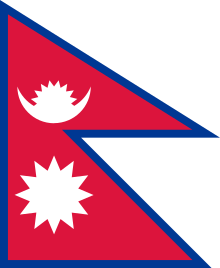

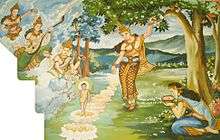

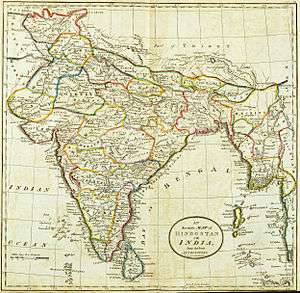
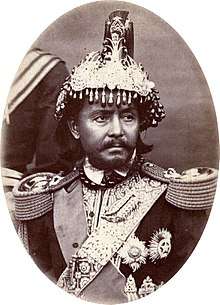


.svg.png)